Performance
Accomodation.
Report error

Tell us what's wrong
We do our best to fix any errors in boatpedia. thanks for the help.

By Product Categories
Small Boat Blocks
Big Boat Blocks
Complementary Hardware
Travelers & Genoa Leads
Mainsail Handling
Headsail Handling
Mooring Solutions
Spare Parts
Accessories
Harken Canvas
Sportfishing
Fly Soft-Attach Blocks
Carbo Air Blocks
Small Boat Classic
Flip-Flop Small Boat
GP Catamaran Ceramic Mainsheet Systems
Protexit™ Exit Blocks
Through-Deck
Wire High-Strength
Dinghy Vang
Small Boat Deck Organizers
Midrange Classic
Midrange Deck Organizers
Zircon Blocks
Element Blocks
Black Magic Air Blocks
Cruising ESP Blocks
Megayacht Blocks
Stainless Steel Blocks
Black Magic Air Runners
FlatWinder Powered Blocks
Mastbase Blocks
Over-the-Top
Crossover Blocks
Big Boat Deck Organizers
Cam Cleats & Kits
Cam Cleat Accessories
Cam Cleat Bases
Stand-Up Bases
Deck Organizers
Spinnaker Pole Cars
Soft Attachments
Fixed Padeyes
Removable Padeyes
Bolt-Down Fairleads
Grand Prix Jib Leads
Halyard Tensioners
Tiller Extensions
Peter's Desk Drawer
Dinghy Jib Leads
Crossbow Pivoting Self-Tacking Jib Traveler
13 mm Micro
22 mm Small Boat
27 mm Midrange
32 mm Big Boat
Windward Sheeting
42 mm Mini-Maxi
T-Track Genoa Lead
Access Rail System
13 mm AA Battcar System
22 mm A Battcar System
27 mm B Battcar System
32 mm C Battcar System
18 mm Switch Battcar System
26 mm Switch Battcar System
26 mm Trysail Switch
32 mm Switch Battcar System
32 mm Trysail Switch
40 mm Switch Battcar System
40 mm Trysail Switch System
Furling Mainsail Outhaul Systems
Single Line Reefing
Harken Vang-Master
Carbo Racing Foil
Small Boat Furling
Small Boat Underdeck
Reflex Furling
MKIV Jib Reefing & Furling
MKIV Underdeck Jib Reefing & Furling
Furling Accessories
Powered Furling
MKIV Ocean Furling
SnubbAir (Not a Winch)
Grand Prix Winches
Air Winches
Circuit Breakers
Analog Switches
Digital System Switch
Aluminum, Chrome & Bronze Winch Handles
Carbo OneTouch Locking Winch Handle
Service Kits
CLR Mooring Winches
Electric Captive Reel Winches
Hydraulic Captive Reel Winches
UniPower Radial
Single-Acting Integral Backstay Adjuster
Single-Acting Cylinders
Locking Cylinders
Double-Pull Cylinders
Grand Prix Cylinders
Hydraulic Cylinder Rod End Blocks
Hydraulic Cylinder End Fittings
Control Valves
Control Manifolds
Control Panels
Compact Control Panel
Rotary Pumps
Hydraulic Pump Handles
Power Systems
Repair Kits
Ball Bearings
Block Spare Parts
Traveler Cars
Furling Spare Parts
Winch Spare Parts
Winch Service Kits
Blockheads Gear
Promo & Gifts
Marine Grip
Blue Performance
Jeep/Truck tops
Garage storage
One-design Covers
Boat accessories
Canvas bags
By Type of Sailing
Dinghy / One-Design
Offshore Racing
Coastal / Day Cruising
Bluewater Cruising
Megayachts / Custom
Service Guide
Tech/Service
deck layouts
Data Sheets (SDS)
How to choose
System diagrams
Calculators
Reeving diagrams
Traveler Purchase Selection Guide
How to Choose
Testimonials
Hoister Videos
Request a Quote
Request Samples
Fabric details
Cover Styles
Canvas Videos
Contract Services
Materials and Components
Our Equipment
Contract Cut-and-Sew Project Spotlight
- Harken at the front
- Safety & Rescue
Support / One-design deck layouts
470 Deck Layout

Spinnaker Pump Halyard System
A 1:2 reverse purchase on the halyard allows the skipper to raise the spinnaker twice as fast. Pulling the pump handle .6 m (2 ft) off the cockpit floor raises the spinnaker 1.2 m (4 ft). A 1:5 shock-cord halyard take-up system automatically manages accumulating line during the rapid chute deployment.

The cascaded vang uses super strong single, double, and triple 16 mm blocks for a powerful 16:1 mechanical advantage. The skipper can play the vang from either side of the boat.

Two-Car Mainsheet
This fast-tacking two-car system halves the distance a single car would travel. The bridle and the 2:1 side-to-side traveler controls raise and lower the floating mainsheet block for perfect mainsail twist. Mainsheet tension tightens the leech and reduces twist.
If you would like to link to or reprint this article please contact [email protected]
Class History
The International 470, designed in 1963 by 505 sailor André Cornu, is a high-performance planing dinghy for both men and women. Responsive to weight placement, this two-person one-design is tactically demanding and requires fluid coordination between the skipper and crew. The 470 is easy to sail, but racing and flying the spinnaker from the trapeze provides additional challenges for sailors. The 470 made its Olympic debut in 1976, and in 1988 was selected for the Games first women's sailing event.
Links International 470 Class McLube™ Harken Canvas
Boat Specifications
Length: 4.7 m, 15 ft 5 in Weight: 120 kg, 264 lbs Sail Area: 12.7 sq m, 137 sq ft Jib: 3.58 sq m, 39 sq ft Main: 9.12 sq m, 98 sq ft Spinnaker: 13 sq m, 140 sq ft

Related products

29mm Block — Swivel

13mm Low-Beam Track — 1.2 m

16mm Double Block

16mm Double Block — Becket

16mm Triple Block

16mm Cheek Pivot Block

16mm Through-Deck Block

29mm Stand-up Block

29mm Through-Deck Bullet Block

Micro Cam-Matic® Kit — X-Treme Angle Fairlead

22mm Eyestrap Block

22mm Cheek Block

13mm Car — Pivoting Shackle

Standard Cam-Matic® Cleat - 150
Product categories.
- United States
- New Zealand
- United Kingdom

Lift. Launch.
Buy a Hoister on Harken.com. Get a free hat! Ends when we run out of free hats.

2022 Dufour 470 Technical Specs
General data about dufour 470.
| Brand | |
| Model | |
| Boat Type | |
| Category | |
| Year Of Production | |
| Condition (New/Used) | |
| Country | |
| Fuel (Gas/Diesel) | |
| Hull Material Used | |
| Length | |
| Selling Price | |
| Vat Status | |
Engine and Power Specs
| Engine manufacturer |
Dimensions And Wieght
| LOA (Length Overall) | |
| Beam Width |
Detailed Specifications
| Number of Heads (Watercraft) |
Features And Equipments
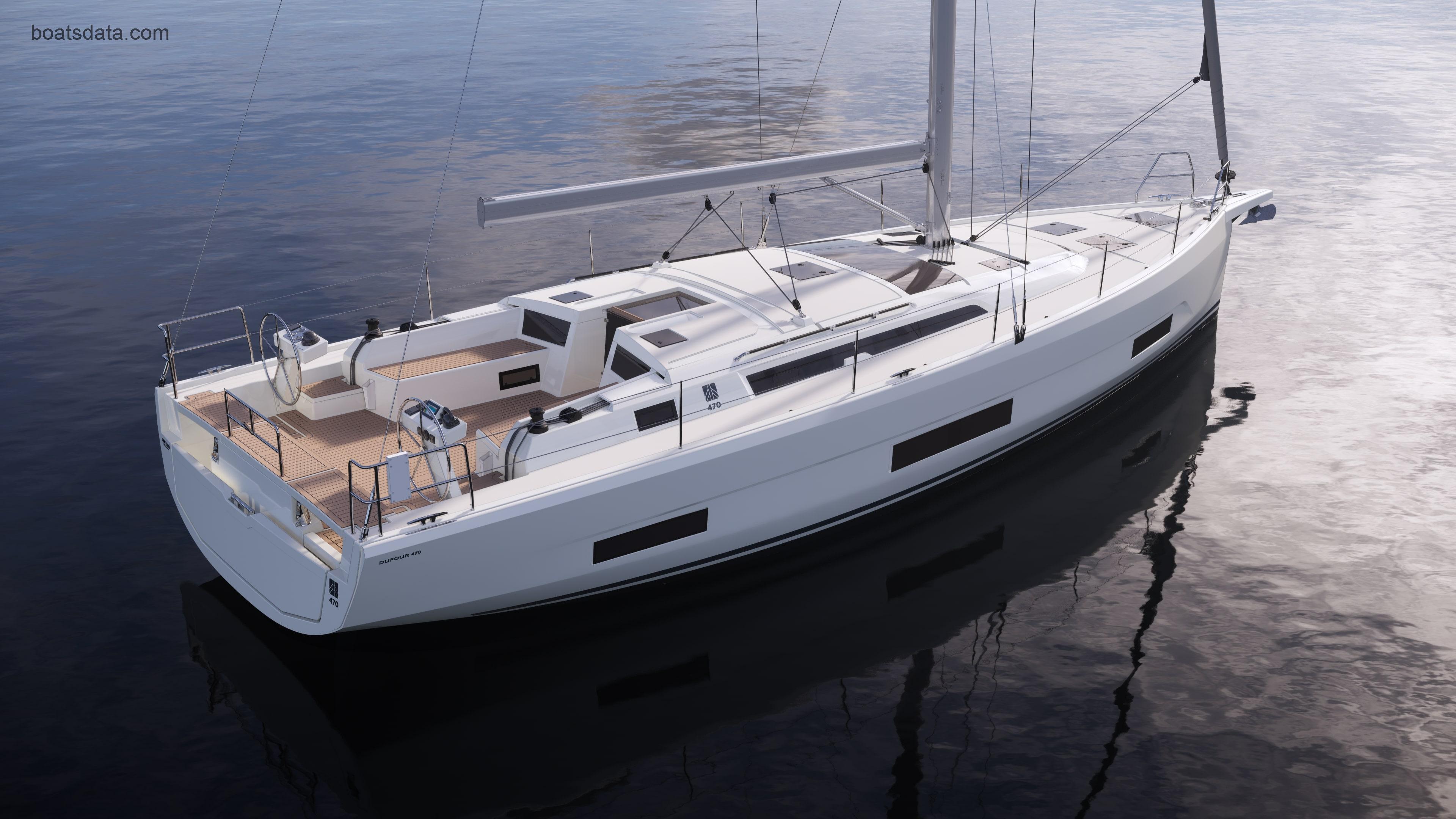
More 470 models
- Dufour provided us with the latest version of its 470 service repair manual
- Find All mechanical and electrical parts and accessories of Dufour 470 Sail here
Dufour 470 competitors
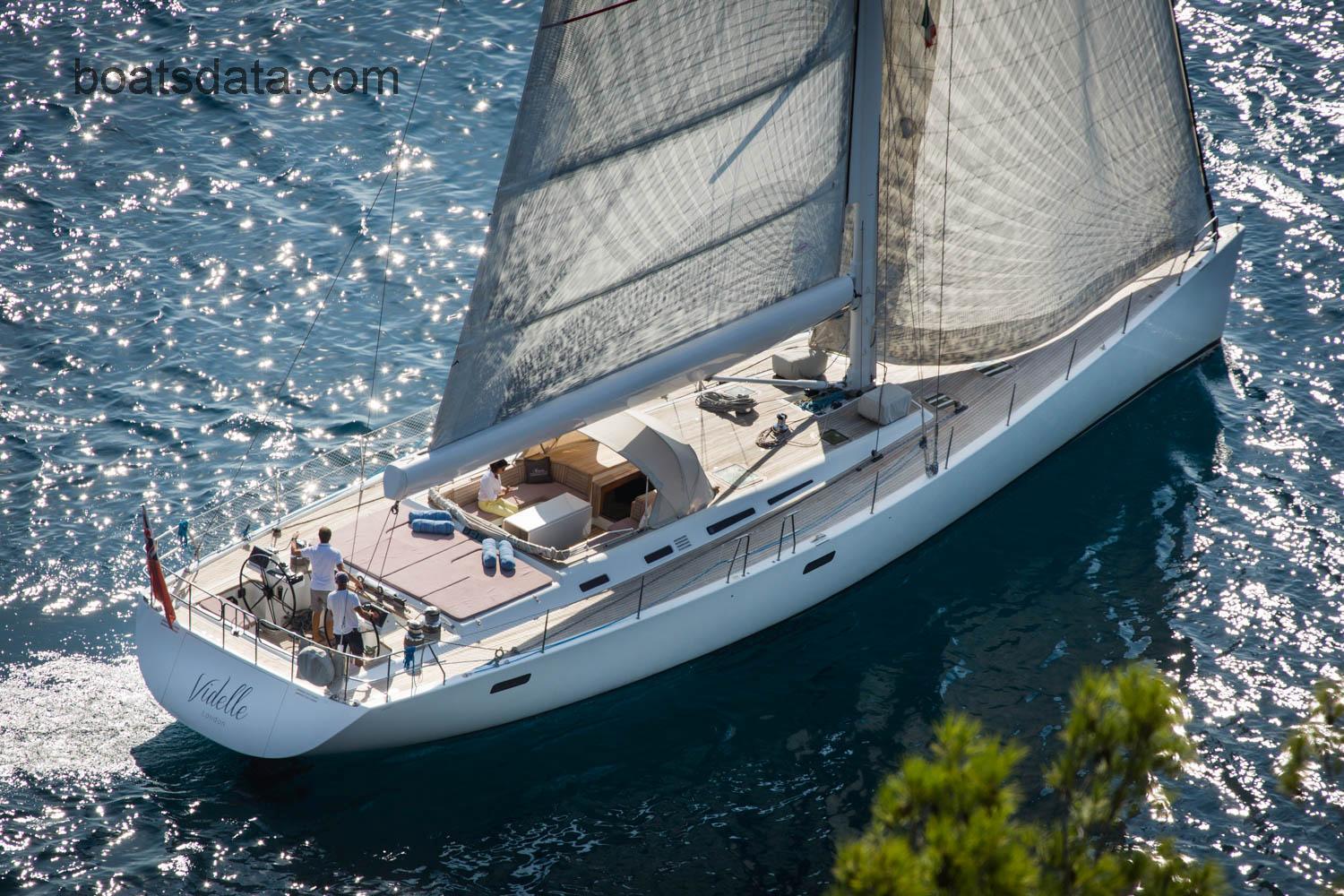
The Worldwide Leader in Sailmaking
- Sail Care & Repair
- Sailing Gear
- Find A Loft
- Sail Finder
- Custom Sails
- One Design Sails
- Flying Sails
- New Sail Quote
- 3Di Technology
- Helix Technology
- Sail Design
- AEROTECH Spinnaker Cloth
- NPL RENEW Sustainable Sailcloth
- Sailcloth & Material Guide
- Polo Shirts
- Sweaters & Cardigans
- Sweatshirts & Hoodies
- Accessories
- Shop the look
- Mid & Baselayers
- Deckwear & Footwear
- Luggage & Accessories
- Fall Winter '24
- North Sails x 37th America's Cup
- Sailor Jackets
- SALT X North Sails
- NS x Slowear
- T-shirts & Tops
- Sailor Jacket
- Sustainability
- North Sails Blog
- Sail Like A Girl
- 37th America's Cup
- Icon Sailor Jacket
- Our Locations
- Certified B Corporation
- North SUP Boards
- North Foils
- North Kiteboarding
- North Windsurfing
SAIL FINDER
SAILING GEAR
COLLECTIONS & COLLAB
COLLECTIONS
WE ARE NORTH SAILS
ACTION SPORTS
Popular Search Terms
Organic cotton
Scuba fleece
Drawstring hood
Utility pocket
Stand collar
Sorry, no results for ""
Subscription
Welcome aboard.
We want to make our emails as relevant as possible for you.
Interests saved
Something went wrong, please try again
Welcome to North Sails
Stay up to date with the latest North Sails news.
Receive a 10% discount code for your first apparel order. Excludes sails and SUP’s. See our Terms and Conditions .
Yes, I agree to the terms of use and privacy policy.
470 SPEED GUIDE BY SÎME FANTELA
Who sails the 470.

What does it take to be successful in the 470?
Who does what on the boat, what are the keys to rig set-up, what are the keys to rig tuning.
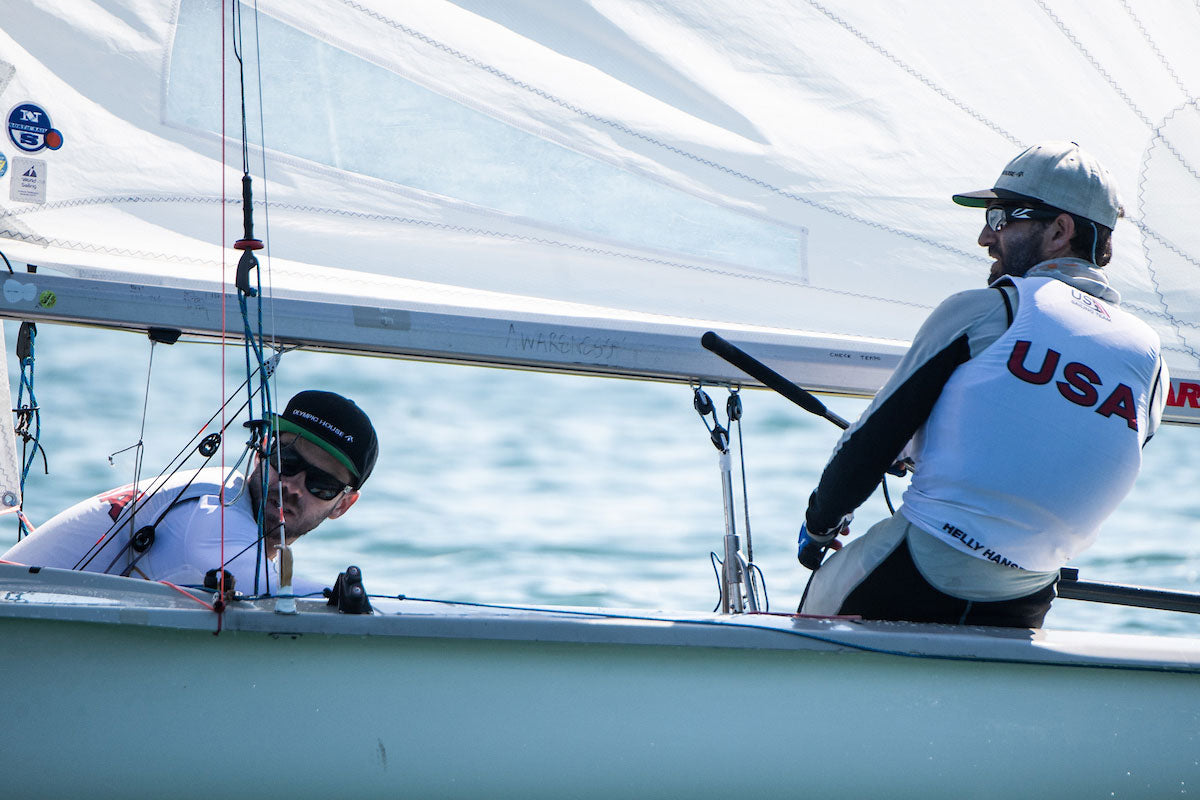
Upwind Sailing
Where does each person sit on a 470 in light air, what are the key changes in different conditions, what do you focus on when trimming the 470 main, what do you focus on when trimming the 470 jib, what are the key adjustments to make when wind and sea state increase, any other advice about gear changing in a 470, what's the typical conversation between 470 helm and crew.
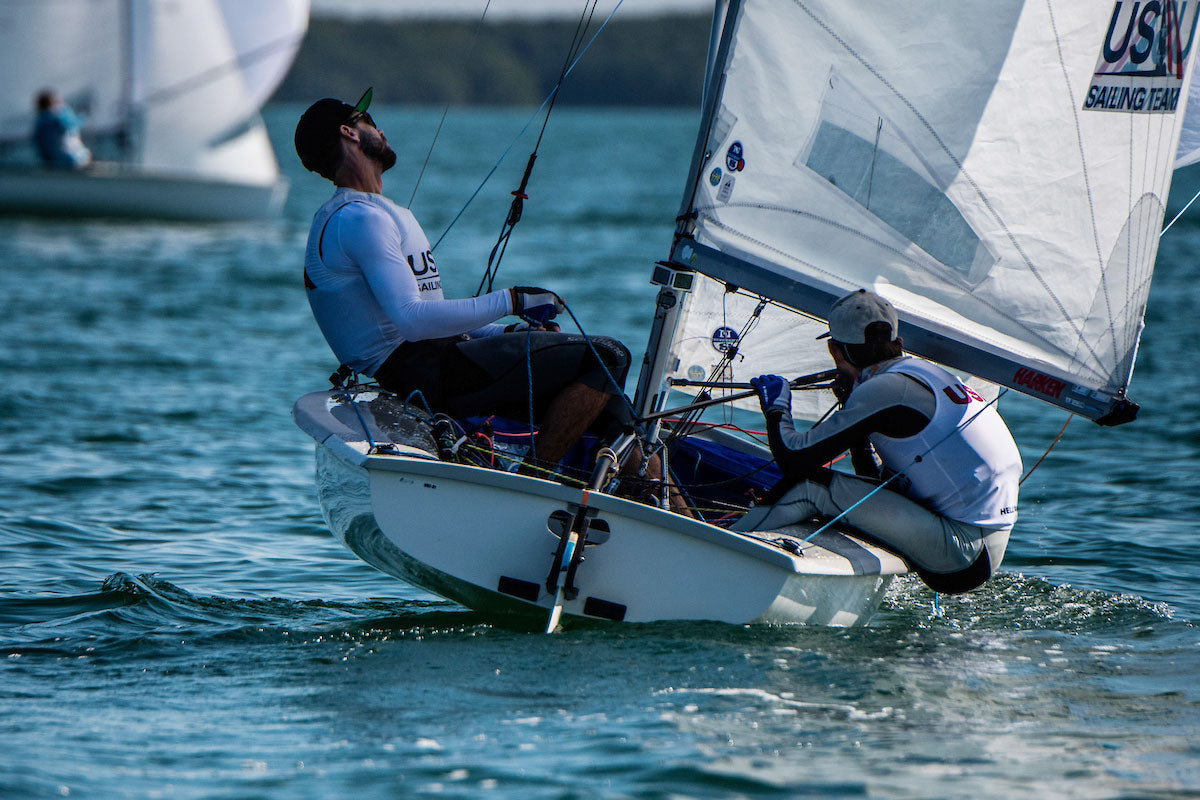
Downwind Sailing
What 470 spinnaker would you recommend, where does each person sit in a 470 downwind, what are the key adjustments to make sailing downwind, what’s the most important thing about 470 trimming downwind in light air, what’s the most important thing about 470 trimming downwind in heavy air, what is a typical conversation downwind.
- What mode do we want to achieve (high and fast, or low and slow)?
- Is the Oscar flag up so we are allowed to pump?
Any special considerations to sail the 470 well downwind?

Boat Handling
Top three tips to starting a 470 well.
- Try to keep the flow on the rudder and centerboard as long as you can. Once you lose that, it can take some time to attach again.
- Always fight for space down to leeward. If you don't have enough, you're not going to survive the first 100 meters.
- Identify the last possible moment for a double tack. And whether you double-tack or not, know the right time for good acceleration and the right exit angle.
Any tips for 470 downspeed boat handling?
What is the most common mistake when tacking a 470, what does each person do in a tack, key tip for good light-air tacks in a 470, key tip for good heavy-air tacks, key tip for good light-air jibes, key tip for good heavy-air jibes, what’s the best way to set a 470 spinnaker who does what.
- Come in off the trapeze wire.
- Take the spinnaker tack out of the spinnaker bag with one hand, while pulling on the windward barber-hauler/twing with the other hand.
- Hook the pole to the sheet, topping lift, and mast - Jaws up!

What’s the key to a good 470 spinnaker takedown?
Personal Tip: We always have a windward takedown, because we have a storage bag on each side of the boat.
Doing a 720 penalty turn is slow. What are the keys to minimizing the pain?
How easily does the 470 broach or capsize, how do you recover from a 470 capsize, what are the most common boat helming mistakes made in the 470 class, any suggestions for drills to improve 470 boat handling.
GET IN TOUCH
REQUEST A QUOTE
BROWSE ALL SAILS
FIND YOUR SAIL
Latest north sails news.
17 September
FOUR KEY COMPONENTS TO OFF-SEASON SAIL CARE
16 September
AEROTECH FAQ
Travel journal: at home in tarifa.
- Refresh page
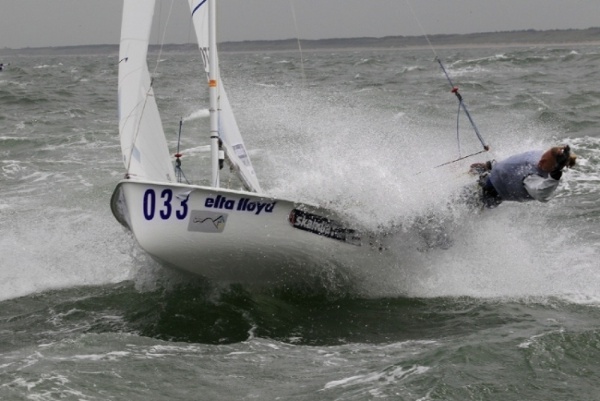
Harnessing technical, tactical and athletic performance, all in one package.
Since our first build in 1993, a Mackay built 470 has helped produce Olympic glory and world champion sailors year on year.
Find out more in the Features section below
Specifications
Hull Length 4.7
Beam Length 1.7
Mainsail Area 9.45 m2
Headsail Area 3.59 m2
Spinnaker Area 12.16 m2
Boat Weight 120 kg
Number of Trapeze Single
Year of status 1969
Type Centreboard Boat
No. of Crew 2
Opt Crew Weight 110 - 145
Hull Material GRP
The 470 is a double handed, mixed crew Olympic yacht.
470 Class Association website : http://www.470.org/
The 470 is a light and narrow boat (length 4.7m and beam 1.7m with a weight of 120kg), that responds easily and immediately to body movement.
The skipper is normally smaller and lighter (1.65m to 1.8m and 55kg to 65kg) and the crew is taller (1.75m to 1.85m yet only 65kg -75kg). The crew's build lets him or her hang far out on the trapeze to keep the boat level in all conditions.
Since our first build in 1993, a Mackay built 470 has helped produce Olympic glory and world champion sailors year on year. Over the years we have refined our knowledge on what makes this boat go fast.
Our boats have a reputation for high strength and stiffness . We focus on these two areas so that the boat will hold high rig tension and not flex in the bow and mid sections.
It also means that the tune of the boat will not change through a season of racing so that the rig tensions and mast bends will not alter as the season progresses.
In 2018 we produced a new mould which we believe is the ultimate for a mixed crew combination heading to Paris 2024.
The mould is designed to maximise the energy from body pumping while also making the boat easy to sail. It was designed with help from sailors, Nathan Wilmont and Jo Aleh, who worked alongside our navel architect, Kevin Trotter.
Part of the success with our latest design comes from adding a little bouyancy in the back of the boat which will make it easier to steer in waves and easier to catch small waves downwind. Bouyancy is also added in the front to balance the changes in the stern.
All of the ribs on our boats are vacuum clamped foam with chopped mat and uni-directional rovings on top. We obtain extra strength from the rigidity of the foam itself.
The construction techniques we use give greater longevity and therefore eliminate the need to replace the boat every year or two. We believe that our construction techniques are as advanced as allowed by the rules.
The building process also involves a considerable amount of custom workmanship. We concentrate on building fewer boats but of a very high quality. We have placed the greatest importance on workmanship, care and attention to detail.
International 470 Class History
In 1963, French architect Andre Cornu designed the two-handed centerboard boat as a modern high performance fiberglass planing dinghy which could be sailed by anyone. And the craft so influenced European sailing that the 470 is directly credited with drawing new sailors to the sport during the 1960s and '70s.
The 470 has been an Olympic class boat since 1976. It is sailed today for both family recreation and superior competition by more than 30,000 sailors in 42 countries worldwide.
In 1988, women officially entered Olympic sailing competition with the first-ever 470 Women's event. This boat is especially well-suited to women's competition because of its light weight, maneuverability and light crew weight requirement.
Click here to view more information on the history of the 470.
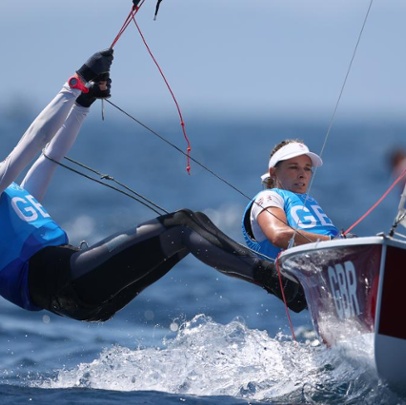
470: Recent Success for Mackay Boats
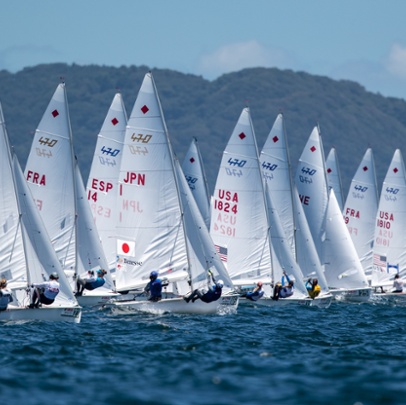
470: The history of its success
Can mackay's customise the layout of the boat.
Yes. Nearly all 470 are customised to suit your own preferences.
What can be customised?
We offer options for most control systems on the boats. Go to our 470 order form to see the options available. International 470 Package - Mackay Boats - NZL
Can you do other fitout options not on the list?
Yes. Many teams send us pictures with their own personal systems for us to copy.
What fitout options do the top crews choose?
All teams have something slightly different, but generally most top teams choose the continuous rig tension system (Option c) , the 4:1 up with 2:1 down centreboard system (Option a) and the carbon jib brackets. These are the only 2 systems that most top teams have in common.
How to do a gelcoat repair?
Small gel coat repairs are relatively easy to do.
What is Gelcoat made up of?
Gelcoat is a polyester product that is cured by using a catalyst called MEKP. (Methyl Ethyl Ketone Peroxide)
MEKP is a dangerous substance and should be treated as such when using, being very careful not to get any on your skin or in your eyes.
How can I get the catalyst - MERK?
We cannot ship MEKP so you will always need to buy it separately from your local marine store or fibreglass manufacturer.
How much MERK do I need?
The amount of Catalyst varies depending on the conditions you are using it in, but around 2%-3% will always work.
It is best to use a small syringe or dropper to get the required catalyst rate.
If you have mixed 100gm of gelcoat, then you are aiming for 2ml of catalyst.
What are the Gelcoat colours?
Gelcoats colours are not always a 100% perfect match.
Colour will vary depending on the depth of the repair and the batch.
470 White- LS30 White PA 337
470 Grey- Grey RAL 7035
Blue = is supplier by Nuplex who have their own code which is not an international code
Does Mackay Boats supply gelcoat?
We supply a small tin (of each relevant colour) with each new boat.
Order additional gelcoat from our store, although it cannot be shipped by courier.
How do I do gelcoat repairs?
Doing gelcoat repairs is an art that improves with experience.
Making sure the surface is prepared well and keyed up is critical.
Overfill and then sanding back is a slow and time-consuming process.
Be very careful not to scratch the boat around the repair.
You shouldn’t sand the original surface around the repair with any paper coarser than 600grit.
Mask around the repair to protect the boat.
You can initially use a file or 150g to take the high parts off the filling, but don't use the coarse paper for too long or you will end up with scratches in the finished repair.
Once you have it fair with 600g, you can work your way through the sandpaper grades until you finish with 1500grit before cutting and polishing.
We would typically use 600g, then 800g or 1000g, then 1200g, then finally 1500g.
How do you fit a mylar gasket to a 470?
Please watch a demonstration: Fitting a mylar gasket
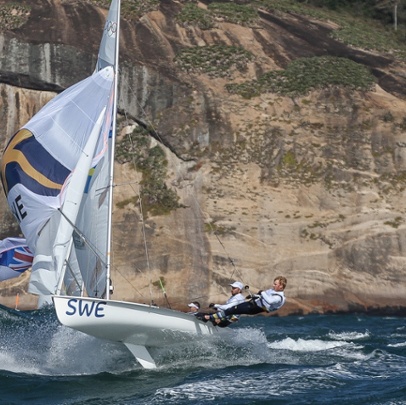
470 Tuning Tips
Are you sure you want to change currency.
An Olympic-class racing dinghy, the 470 is the double-handed sailing discipline for both men and women. The strict, one design class has proven itself as an Olympic event since 1976. Originally an open class, it split into men’s and women’s divisions in 1988.
- Class Experts
- Links & resources
470 Mainsails
470 Main Boludo
This time-tested, successful design accommodates all types of sailors and needs. It’s a pure AP main. Championships include: 2002 European gold medal, 2002 Pre-Olympics gold & silver medals, 2002 World bronze medal.
This product may be ordered through your local rep or a class expert.
470 Headsails
470 Jib SR31
Semi-Radial Jib
470 Spinnakers
470 Spinnaker Q1
Made of a light polyester from Teijin, this sail is so fast it’s hard to get a close-up photo! Championships include: 2010 World silver medal, 2011 World bronze medal, 2012 Olympic gold medal. With more volume on top and flatter on the bottom, this sail is intended for pure downwind; a very stable kite.
Choose a Team Member
Alejandro Irigoyen
- P: +54 911 5421 9803
- E: [email protected]
Alejandro Irigoyen started sailing when he was 12 years old. His father was a keen sailboat racer at the Yacht Club Argentino, and Alejandro spent his weekends racing and living aboard the family’s wooden S&S Finisterre. By the time he graduated high school, Alejandro knew he wanted to dedicate his life to sailing, so he started studying yacht design. He started his sailmaking career in 1982 working for Hood, before starting his own Sobstad loft. In 2001, Alejandro joined the Quantum Sails family. “It was a natural decision,” he said. “I shared the same view and goals as the founding group.” Though he’s sailed in various classes, Alejandro’s expertise includes Optimist, Cadet, 470, Snipe, J/24, J/70, J/105, Soto 33, and Soto 44 classes. Whether he’s sharing his class knowledge and experience, or helping customers organize their campaigns and training, Alejandro’s passion for excellence provides the best service, products, and support for his customers.
- Nationality: Argentina
- Current Town:
Career highlights
- 15-time National Champion in Argentina, Chile, Brazil, and Peru
- 6-time South American Champion in Cadet, 470, J/24, and Soto 40 as helm/skipper
- Coached 470 Olympic bronze medalist teams in 2000 & 2012
- Coached Soto 40 Team Negra in 2010 & 2013
- Has successfully raced as helm/trimmer/tactician on board various One Design and offshore boats at regattas in more than 30 countries around the world
Carlos Rodriguez
- P: +34-93-2242778
- E: [email protected]
When Carlos Rodriguez was four years old, his mother worked for a One Design boat company. She started taking him to races on the weekends, and it didn’t take long before Carlos started racing. When he was just 17 years old, the Catalonian Sailing Federation offered him a job, and he’s been sailing ever since.
Carlos started working at a Quantum Sails loft in 1996. After learning how to make sails on the floor, service sails, and design sails, he became a salesman. Carlos not only spends almost every weekend racing in local and national events with Quantum customers, serving as a skipper, tactician, and jib-spinnaker-mainsail trimmer, he also trims masts, finds crew members, provides certificate optimization in ORC, and even services sails during races. Carlos now serves as the Spain Regional Manager and works hard to make Quantum Sails Spain a full-service, one-stop loft for all sailing needs.
professional racing crew member since 1995, Carlos has an extensive resume, including experience on Mega Yachts, ORC boats, IRC boats, One Design, etc. He has also won several races like Copa del Rey in Palma, Maxi Yacht Cup, Swan Cup, and many important races in the Spanish ORC circuit.
- Nationality: Spain
- Position: Spain Regional Manager
- Spain Tir (X-362)
- Camper and Trasmediterranea (First 40, 7)
- Freixenet (JV46)
- Zurich (GP42 and BC41)
- Fermax (GP42)
- Santa Anna (JV57)
- Siemmens Mobile (Farr 42)
- Icaro (D44)
- Garmin (DK46)
- Iberdrola (Soto 40)
- Copa del Rey Champion, 2007, 2008, 2009
- ORC Non-Corinthians World Championship – 3rd place, 2007
- Two-time ORC Spanish Champion
Fernando Sallent
When Fernando Sallent was 10 years old, a friend of his father bought him an Optimist dinghy. From then on Fernando was hooked. As an adult, his first business venture was Technik Boats, a small Optimist shipyard, but it was the physics of sailing that really intrigued him. "I always had a passion for finding a way to make boats go faster," he said.
That passion led him to La Industrial Velera Marsal, a local sailmaker who made all of his sails by hand. Fernando worked there learning the basics of sailmaking while also running Technick Boats. After taking a year off to serve in the military, he decided to leave Technick and joined Toni Tio Sail Loft. Toni Tio was only designing cruising sails at the time, so Fernando came on board to lead the One Design section of the company.
In 1996, Toni and Fernando visited the Quantum Annapolis loft, and in 2000 they joined the Quantum Sails team. Fernando continues to design One Design sails as he works to help his clients improve on the water. "I love seeing how sailors do better when the product is improved," he said. "I love the fine tuning of boats and sails on the water."
An accomplished sailor, Fernando also works as a coach for many teams. He coached the 470 women's world, Olympic, and European champions in 1992 and the 470 women's world champions in 1995. Since 2000, he has advised the Norwegian, Swedish, Swiss, and Spanish Olympic teams.
- Position: Sail Designer
- Current Town: Barcelona
- 1992 Olympics – 470 men’s gold medal, 470 women’s gold medal, Europe Dinghy silver medal
- 1996 Olympics – 470 women’s gold medal, 470 men’s bronze medal
- 2000 Olympics – Europe Dinghy bronze medal
- 2004 Olympics – Europe Dinghy gold medal, 470 women’s silver medal, 470 men’s bronze medal
- 2008 Olympics – Tornado gold medal, 470 men’s bronze medal
- 2012 Olympics – 470 women’s gold medal
- 470 Class – 1992-95 men’s world champion,
- 1992/1995-96/2005/2011 women’s world champion
- Optimist – 1993-96/2004 world champion
- Europe Dinghy – 2003-04/2010 women’s world champion
- 2004-06/2010-12 men’s world champion
Maxim Logutenko
- P: +14014998651
- E: [email protected]
Maxim started working in the Quantum Russia office in 2010 after a lifetime of sailing experiences. He started sailing on Optimist boats when he was six years old and became a champion sailor. He is a two-time All-Japan Mini Hopper and Sea Hopper Junior Champion, two-time Quarter Ton class All-Russia Champion, and the 2008 Dragon European Champion. Maxim is also experienced on Cadet, 470, 49er and RC44 boats. When he's not sailing, Maxim also coaches, including the Russian Yngling class for the 2008 Olympics. When Maxim decided to transition into selling sails, he chose Quantum because of its state-of-the-art design and development, as well as Quantum's reputation for quality. He is excited to work with new and repeat clients to help everyone find the fastest, most competitive sails.
- Nationality:
- Position: Sail Consultant
- 2021 Rolex Middle Sea Race, ORC 4, 2nd
- 2003 Rolex Sydney Hobart, Sydney 38, 3rd
- Rolex Fastnet Race Skipper
- Several coastal regattas in Italy/France and Spain as a skipper
- 2007-2008 – Russian Olympic Sailing Team Coach, Yngling class, 4th place
| Date | Regatta | Result |
|---|
- 470 Class Association Website
Youth Corner: Hollywood Moves That Don't Work in Big Fleets
Youth Corner: How to Practice Before the Big Race
Youth Corner: Make Your Dinghy Sails Last Longer
Youth Corner: How to Get the Most Out of Your Coach
This website uses cookies and collects usage statistics. Privacy Policy
Us, too. We pour that passion into each of our newsletters to help you enjoy sailing even more.
Technical specifications - Dufour 470
Photos of the boat, technical features.
- Length HT : 49ft (14.85m)
- Max. width : 16ft (4.74m)
- Weight : 13.2 tons
- Draft : 7ft (2.25m)
- Max. sleeping capacity : 8
- Number of cabins : 3 to 4
- Bathrooms : 2 to 4
- Water capacity : 530L
Standard motorisation
- Engine Power : 60hp
- Fuel capacity : 250L
Standard canopy
- Total sail area : 351sqft (107m2)
- Mainsail area : 187sqft (57m2)
- Genoa/jib area : 164sqft (50m2)
Ideal destinations for renting a Dufour 470
- New Sailboats
- Sailboats 21-30ft
- Sailboats 31-35ft
- Sailboats 36-40ft
- Sailboats Over 40ft
- Sailboats Under 21feet
- used_sailboats
- Apps and Computer Programs
- Communications
- Fishfinders
- Handheld Electronics
- Plotters MFDS Rradar
- Wind, Speed & Depth Instruments
- Anchoring Mooring
- Running Rigging
- Sails Canvas
- Standing Rigging
- Diesel Engines
- Off Grid Energy
- Cleaning Waxing
- DIY Projects
- Repair, Tools & Materials
- Spare Parts
- Tools & Gadgets
- Cabin Comfort
- Ventilation
- Footwear Apparel
- Foul Weather Gear
- Mailport & PS Advisor
- Inside Practical Sailor Blog
- Activate My Web Access
- Reset Password
- Customer Service

- Free Newsletter

Blue Jacket 40 Used Boat Review

Catalina 270 vs. The Beneteau First 265 Used Boat Match-Up

Ericson 41 Used Boat Review

Mason 33 Used Boat Review

How to Create a Bullet-Proof VHF/SSB Backup

Tips From A First “Sail” on the ICW

Tillerpilot Tips and Safety Cautions

Best Crimpers and Strippers for Fixing Marine Electrical Connectors

Polyester vs. Nylon Rode

Getting the Most Out of Older Sails

How (Not) to Tie Your Boat to a Dock

Stopping Mainsheet Twist

Fuel Lift Pump: Easy DIY Diesel Fuel System Diagnostic and Repair

Ensuring Safe Shorepower

Sinking? Check Your Stuffing Box

What Do You Do With Old Fiberglass Boats?

Boat Repairs for the Technically Illiterate


Boat Maintenance for the Technically Illiterate

Whats the Best Way to Restore Clear Plastic Windows?

Stopping Holding-tank Odors

Giving Bugs the Big Goodbye

Galley Gadgets for the Cruising Sailor

The Rain Catcher’s Guide

Sailing Gear for Kids

What’s the Best Sunscreen?

UV Clothing: Is It Worth the Hype?

Preparing Yourself for Solo Sailing

R. Tucker Thompson Tall Ship Youth Voyage

On Watch: This 60-Year-Old Hinckley Pilot 35 is Also a Working…

On Watch: America’s Cup

On Watch: All Eyes on Europe Sail Racing

Dear Readers
- Sailboat Reviews
Catalina 470
Although it conforms to ce ratings for ocean sailing, this boat is better suited for coastal cruising in comfort and short offshore passages. it's got a great set of layout options for living aboard..
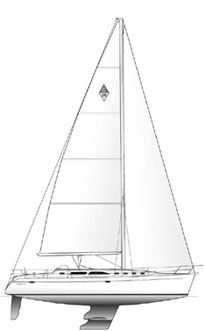
We’ve been soaked to the bone while racing Catalina’s most popular model, a 27-footer on which we crewed in a San Francisco one-design fleet. We’ve raced down the Baja coast steering a squirrelly 38-footer under a masthead kite while winning class honors in the Newport-Ensenada race. Over the years, we’ve sailed and reviewed quite a few Catalinas, and have noted two central characteristics of these boats: They have a pretty good turn of speed and spacious accommodations. We’ve also noted that the company’s mass production techniques occasionally reflect a lack of attention to detail in the fit and finish of joinery.
It has also been impossible to miss the fact that Catalina owners are a ferociously loyal lot who tend to shrug off minor shortcomings by saying “Hey, it ain’t supposed to be a Rolls Royce.”
With the introduction of the Catalina 470 in 1998, the company announced an effort to upgrade the quality of the fit and finish without changing its pricing practices. It also added a legitimate performance cruiser to dealer showrooms. More than 200 of these boats have been delivered already. That’s an amazing production run for a boat of this size in an economy this wobbly. Price-wise, Catalina can keep competing when other, higher-end boatbuilders are startting to duck and cover.
Company History Frank Butler, who founded Catalina Yachts 30 years ago, has always contended that his boats provide owners with good value, and this is true. The company’s product line spans the sailing universe; it offers boats ranging in size from the Capri 22, a daysailor, to the 47-footer described here.

Mindful of the occasional barb about quality control, Gerry Douglas, Catalina’s vice president, chief engineer, and Butler’s right-hand man for two decades, says, “Our owners don’t mind adding that extra layer of varnish. They’re very hands-on, and like to tinker on their boats. I like to think that we’ve given them a stable platform on which they can safely sail anywhere at an affordable price.”
While conducting an inspection and test sail of the 470, Douglas said, “We’ve gone up a notch with this boat, and introduced features that we’ll begin adding to all of our boats 38 feet and longer. There’s also a higher level of sophistication in systems, construction, and finish.
“We designed the boat to appeal to fairly experienced sailors who are comparison shoppers. For many, this will be a crossover boat—for people moving up from 40-footers, and people switching to Catalina from other brands. The typical buyers are 55 to 60 years old, perhaps semi-retired. They want performance, to cruise under sail, not power. They have a wish list with regard to accommodations. Systems are very important.”
Design/Appearance Overall, the hull is nicely proportioned, with a nearly flat sheer that runs to the down-curved stern sections. The 14-foot beam is moderate for a modern 47-footer, and runs well aft, almost to the transom area. This adds some initial stability as well as interior volume aft. The straight sheerline works well with the house, which carries long, narrow ports to produce an illusion of movement. Though she carries huge interior volume, she does not appear clunky.
According to Gerry Douglas, the hull is easily driven with the moderate sailplan, and doesn’t pound in a seaway. We weren’t able to sail her in lumpy enough conditions to confirm that, but she did behave well during our test sail.
Underbody appendages are a 7’10” fin keel or optional shoal draft keel with winglets 30 percent aft of the leading edge. Rudder and keel are elliptically shaped.
“A cockpit should be long enough to sleep in,” says Douglas. As a consequence, seats in the 470 cockpit are 6’2″ inches long, with 11″ backrests. The 39″ long cockpit table seats four, and has a built-in storage bin and molded cup holders.
Unlike any other arrangement we’ve seen, the electrical system for shore power is split between three separate connectors. According to Douglas, this is “so that owners can use smaller cords than those heavy, unwieldy brutes.”
Deck Layout The deck layout is designed for couples who prefer to sail alone without having to maintain a physical fitness routine in order to manage the 1,010 square feet of canvas she flies. Most boats are equipped with furling mainsail systems and oversized electric winches for halyards and mainsail controls. “I don’t think we can have too large a winch,” Douglas says.
Add the Dutchman sail flaking system that comes as standard equipment, and the boat could even be singlehanded in a pinch.
The layout of deck gear is typical of the today’s production boats and the fact that older sailors don’t want to work forward of the cockpit in unruly seas. Internal halyards and sail controls are led aft to Harken 44 two- speed winches and Lewmar rope clutches. Primary winches are Harken 66 two-speed self-tailers.
Catalina continues to rely on Garhauer to provide most of the boat’s blocks, as well as a stainless steel vang. The roller furler is a Schaefer 3100. Standard equipment also includes a Maxwell 1200 windlass.
In addition to contributing to the boat’s appearance, ten Lewmar ports, including two in the cockpit, allow light and fresh air to penetrate spaces belowdecks. Deck hatches are Lewmar low-profile Ocean series.
Despite the boat’s size, and potential use on blue water, the double- spreader rig is stepped on deck. To avoid damaging the deck coring, it sits atop a 1/2″ thick aluminum plate welded to the top of a 5-1/2″ inch diameter compression post. “It’s all metal to metal,” Douglas says.
It’s true that there are plenty of boats with deck-stepped masts sailing successfully offshore, including the Hallberg-Rassy 42, which we reviewed in May of this year. Every time we say we prefer keel-stepped masts for offshore work, we get angry letters—not from the boatbuilders, but from readers who have deck-stepped masts. So be it. We believe keel-stepped masts are ultimately safer, even if they’re noiser, leakier, and more obtrusive belowdecks. Offshore, if something fails, they’re less likely to topple over wholesale—the “buried root” tends to preserve them—and if they do break, they usually leave something sticking through the deck to which a jury rig can be attached. As we noted in the HR42 review, the butt of a keel-stepped mast needs to be secured to the step.
From the standpoint of comfort and safety, handrails recessed below the cabintop prevent bruised legs when the crew is seated without impairing their ability to find a handhold. Three pre-molded indexes under the boom are designed to house an eight-person life raft in a handy, out of the way location. Stanchions are 29″ high, and shroud bases are set in close to the cabintop, which allows close sheeting angles and makes travel between cockpit and foredeck easier.
On boats this size, Douglas considers redundancy in major systems a key element of the design. As a result, the two-wheel steering system is a product of a collaboration between Catalina and Edson. “The entire system is redundant,” says Douglas. ” There are no shared cables or wheels. Each steering wheel has a separate cable system, so if one is lost the other will still function.”
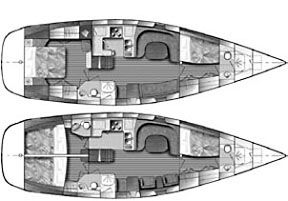
Accommodations Though there’s nothing earthshaking about the general design of spaces belowdecks, the 14-foot beam produces 11 feet of room amidships, continuing Catalina’s tradition of maximizing living spaces.
Improvements in the quality of the interior are subtle. Multiple layers of smooth satin varnish are hand-laid on wood surfaces. The edges of cabinetry, doors and corners, where wear or abrasion may be noticeable, are made of solid teak to prevent blemishes. Lockers and cabinets are fitted with lights that automatically turn on when doors open. Since Catalina now builds cushions in-house, berths are supplied with 7″ thick residential-grade mattresses with powder-coated springs that prevent rust marks on bedding. All of the cabinetry hardware is provided by one company, so replacement of damaged equipment is a small task.
Owners can select stateroom layouts from three optional configurations. In the standard two-stateroom configuration, the forward cabin houses a Pullman berth and shower compartment in an area large enough to house a washer and dryer combination. Aft is a queen-sized bunk on an island. As an alternative, layout No. 2 splits the aft section of the boat into two cabins, each with its own head compartment. An island berth in the forward cabin is an option in this configuration. The third layout offers the option to remove cabinetry from the port stateroom to convert the space into an enclosed workshop. Nice idea!
Headroom in the saloon is 7′ 4″, and length on the centerline approximately 11′ 6″. Seven ports on each side of the hull, and 11 Halogen lights in the saloon and galley, produce a bright space, even on foggy day.
Seven companionway steps cover the engine. Since the cover is a bulky fiberglass box with an aluminum frame, the addition of a gas piston spring that holds the section upright is a helpful addition. Once that’s elevated, access to the sides and front of the Yanmar engine, fuel and water filters, is excellent.
“To prevent contamination, and monitor consumption, boats are equipped with two separate fuel systems and five water tanks,” says Douglas. “If one goes bad, no more than 20 percent of the supply will be lost. There are two independent waste systems. Tanks, hoses, and through-hulls operate independently.”
Though the boat is not intended for use in a charter fleet, tanks are thick enough to meet charter regulations. “We did that because it would be more difficult to change in the future.”
Creature comforts in the main cabin include a C-shaped settee with seating for six to eight adults around a highly polished table. Stowage below the settee is in a watertight compartment, eliminating the risk of bilge water penetrating stores.
Depending upon owner preference, seating to starboard may be on a 6′ 6″ bench with space below for 50 gallons of fuel, or on two upholstered swiveling chairs.
On a boat of this size, there should be plenty of room for the navigator, and Catalina does a good job in this regard. The 470 is equipped with a proper chart-sized table and room for electronics. Forward of the nav table there’s a slide-out table for a TV/VHS combination, radio, and Sony CD changer, all of which are standard equipment. Circuit breakers on the electrical panel are illuminated—a real plus after sunset.
It’s axiomatic that bigger boats have bigger galleys, and the 470 is no exception. Located to port, it offers a chef plenty of elbow room, counter space, and a portlight outboard that provides a view. Counters are constructed of Grancoat®, a tough fiberglass material that’s easy to maintain. A dry locker that could be converted to a refrigerator is located outboard to port, and a cabinet with glass doors is located on the aft bulkhead. The stove is a three-burner Princess with oven and a stainless steel hood fitted with halogen light. A microwave stored in a cutout will accelerate prep time of hot drinks for the midnight watch crew.
In all, living quarters are spacious and well-organized, and fit and finish are a cut above her predecessors.
Construction This Catalina is built at the company’s Florida factory. A completed boat consists of four components: the hull; a structural grid liner that absorbs and diffuses chainplate and mast loads and houses the engine bed; a liner running from bow to stern that does not provide any structural support but forms furniture, beds and cabinets; and, finally, the deck.

The hull to a point 6″ above the waterline is solid fiberglass impregnated with vinylester resin in the skin coat. The lamination schedule calls for hand-laying 2-oz. chop and 8 layers of mat and roving to produce a 1″ thick bottom. Topsides are cored with Baltec AL 600 balsa. A collision bulkhead at the aft end of the anchor locker fills the area between the deck and bottom of the hull; it is glassed to the hull.
The deck is constructed of layers of chop, mat, and roving cored with 1/2″ thick balsa. Pre-tapped, 3/8″ thick aluminum plates are bedded in areas where deck hardware will be installed.
Chainplates also show a new design, not used on any other Catalina models. Says Gerry Douglas, “It’s a ball- and-socket arrangement that locates chainplates through a round hole in the deck, rather than a slot. This method spreads loads, and they are perfectly bonded so there’s no problem with leaks. They are also self-aligning.” (Leaky chainplates have been a common source of criticism for Catalina yachts.)
Despite being a relatively complicated boat, most wiring and plumbing runs are easily accessible under floorboards and seat covers, and color coded for identification. Wiring runs are in half-round PVC bonded to the hull. A 118-page owner’s manual provides schematics of all of the boat’s mechanical systems, and should help to make most things clear even to those who may be “mechanically challenged.”
Performance Invited aboard by Douglas and Seattle dealer Carl Rafello, we tested the 470 on a fall afternoon in which predicted 10-15 knot winds did not materialize. However, we did ferret out the 470’s personality in 6-8 knot winds. In that light air she performed well enough to sneak into our definition of “performance cruiser,” although that phrase is amorphous enough to include a lot of boats in different conditions.
Her rated sail area of 1,010 square feet (100% foretriangle), combined with her wing-keel configuration displacement of 26,500 lbs., gives her a SA/D ratio of 14.01—in the lower ranges of what we might hope for in the horsepower department. Change to a fin keel and she immediately drops 1,800 pounds of displacement; add the optional taller rig for sailing in predominately light winds, and SA increases to 1,092 square feet. This combination allows a SA/D of 18.9, a much more blood-stirring figure. In that configuration, the D/L drops to 160, and she actually ends up in the upper reaches of the light-displacement category.
Sailing with the standard rig and fin keel under a 135-percent genoa, we recorded 5-6 knots of boatspeed off the breeze. Upwind, when pressed, she could sail within about 40 degrees of the apparent wind without loss of speed. Our upwind and downwind boatspeeds were about the same in that breeze. The helm is light, sight lines from both wheels are excellent, and our test boat tacked easily through about 90 degrees.
The limit of positive stability (LPS) of the 470 is listed at 126 degrees, which is within the acceptable range for offshore boats, and in fact she’s rated as a Category A (“Ocean”) cruiser under CE requirements. While we don’t doubt the boat’s essential structural integrity, or that she could cross an ocean in the right hands, she’s really not set up for that. (For example, aside from the mast issue, there are no sea berths, which might be OK on a downwind sail to Hawaii, but wouldn’t be too great on a long starboard tack to Bermuda.)
Conclusion Our test provided, at best, a hint of the performance potential of this boat. Nonetheless, given proper conditions we would expect her to sail at her calculated hull speed of 8.5 knots.
A prospective buyer must carefully evaluate typical conditions in the area where the boat will be sailed, and match sail area and keel configuration accordingly. The deep-keel, tall-rig combination will certainly maximize the boat’s performance. (Those are big jumps in both SA/D and D/L numbers up there.) Given deep enough home waters, this would be the way to go. With that set-up, we could expect her to record 150-200 mile days off the wind under a cruising kite.
Well-conceived mechanical systems make the 470 easy to sail. Be aware, though, that there are of lot of these systems, from the dual steering to the rather complex lighting and entertainment wiring. The harder you sail this boat, the more scrutiny and maintenance these systems will require.
In terms of creature comfort, the boat is excellent—spacious on deck and gracious below. Her list of standard equipment is extensive; add electronics and a 150% genoa, and stores, and she’ll be ready for a coastal cruise. Add electric winches and a mainsail furling system, and the task becomes easier (although more complicated).
Following the company’s philosophy, the 470 is moderately priced at $265,510 (FOB Largo), in the ballpark with similarly sized production boats like the Beneteau 473, priced at $231,000. (Close scrutiny of the list of standard gear is necessary for a complete comparison of pricing.)
The strengths of the 470 lie exactly where Gerry Douglas placed them for his potential market: She’s set up very intelligently for coastal cruising, living aboard, and the occasional coastal hop of a few hundred miles in offshore conditions. That’s plenty to ask of a production boat of this size and price, and the 470 seems to answer those demands nicely. She also comes with a devoted support network of owners.
Contact- Catalina Yachts, 818/884-7700, www.catalinayachts.com .
RELATED ARTICLES MORE FROM AUTHOR
Leave a reply cancel reply.
Log in to leave a comment
Latest Videos

Cabo Rico 34 Boat Review

Super Shallow Draft Sailboat: The Leeboard Sharpie

Hans Christian 41T – Boat Review

Seven dead after superyacht sinks off Sicily. Was the crew at...
Latest sailboat review.

- Privacy Policy
- Do Not Sell My Personal Information
- Online Account Activation
- Privacy Manager
× You are using an outdated browser. Please upgrade your browser to improve your experience.
We Ship Worldwide! | FREE SHIPPING! for US Continental orders over $99. Click for details.

Shopping Cart
Your cart is currently empty..
FREE SHIPPING! for US Continental orders over $99 click for details
Catalina 470 - Sailboat Data, Parts & Rigging

Sailboat data, rig dimensions and recommended sail areas for Catalina 470 sailboat. Tech info about rigging, halyards, sheets, mainsail covers and more.
Sailboat Data directory for over 8,000 sailboat designs and manufacturers. Direct access to halyards lengths, recommended sail areas, mainsail cover styles, standing rigging fittings, and lots more for all cruising and racing sailboats.
MAURIPRO Sailing offers a full range of sailboat and sailing information to help you find the correct sailboat part, one that properly would fit your sailboat and sailing style. Our sailor's and sailboat owner support team are ready to talk with you about your specific sailing needs, coming regatta, or next sailing adventure.
From all at MAURIPRO, let's Go Sailing!
Copyright © 2024 MAURIPRO Sailing LLC.

2024 470 GERMAN NATIONAL CHAMPIONSHIP OPENED WITH TWO EXCITING RACES

WATCH THE REPLAYS OF PARIS 2024 OLYMPIC GAMES RACES FOR FREE

KEIJU OKADA / MIHO YOSHIOKA WINNERS OF 2024 470 JAPAN NATIONAL CHAMPIONSHIP
Schedule of 2025 470 class championships.
- All featured news

2024 470 LATVIAN NATIONAL CHAMPIONSHIP CONCLUDED IN ENGURE

BRITISH WOMEN’S AND YOUTH AMERICA’S CUP SQUADS UNVEILED

JONATHAN MARTINETTI AND HIS TEAM WON THE 2023 LIGHTNING WORLD CHAMPIONSHIP

EX 470 SAILORS WIN 1ST & 2ND TRANSAT JACQUES VABRE CLASS 40
- All notices
- Now-Upcoming
- Featured events
- All results
- 470 Championships Complete Results Archive
- Sailing World Rankings
- 470 Championship Organization Plan
- World Cup Series
- Bid for a 470 Championship
- The 470 at the Olympics
- 470 Olympic Medallists - 1976 to Date
- Sailors in TOKYO 2020 Olympics
- World Championship
- Junior World Championship
- Open European Championship
- Junior European Championship
- Master’s Cup
- African Championship
- North American Championship
- South American Championship
- Asian Championship
- Oceania Championship
- The First 470
Why Sail the 470?
- About the 470
- Management Committee
- 470 Committees
- 470 Class Membership
- Advertise on the 470 Website
- Make a Payment
- 470 General Assembly Meetings
- 470 Class Documents
- Constitution and By-Laws
- 470 Great Book
- Useful links
- 470 Support & Development Program 2018-2024
- 470 ICA SUPPORT PROGRAMS FOR 2024
- André Cornu Grant
- 470 Athlete and Coach Clinics
- Financial Support Programmes
- You Can Help Programme
- 420 and 470 Joint Programmes
- 470 Race Officials Programme
- 470 Tuning Guides and Boat Preparation
- All About Measurement
- 470 Class Rules
- Buy 470 Sail Stickers
- 470 Aerodynamics
- 470 Equipment Manufacturers
- 470 Class Measurers
- Equipment Used at 470 Championships
- List of suppliers

2021 Worlds Vilamoura POR

2019 Worlds Enoshima JPN
- All photo galleries

2024 Europeans Cannes FRA

Allianz Sailing World Championships The Hague NED
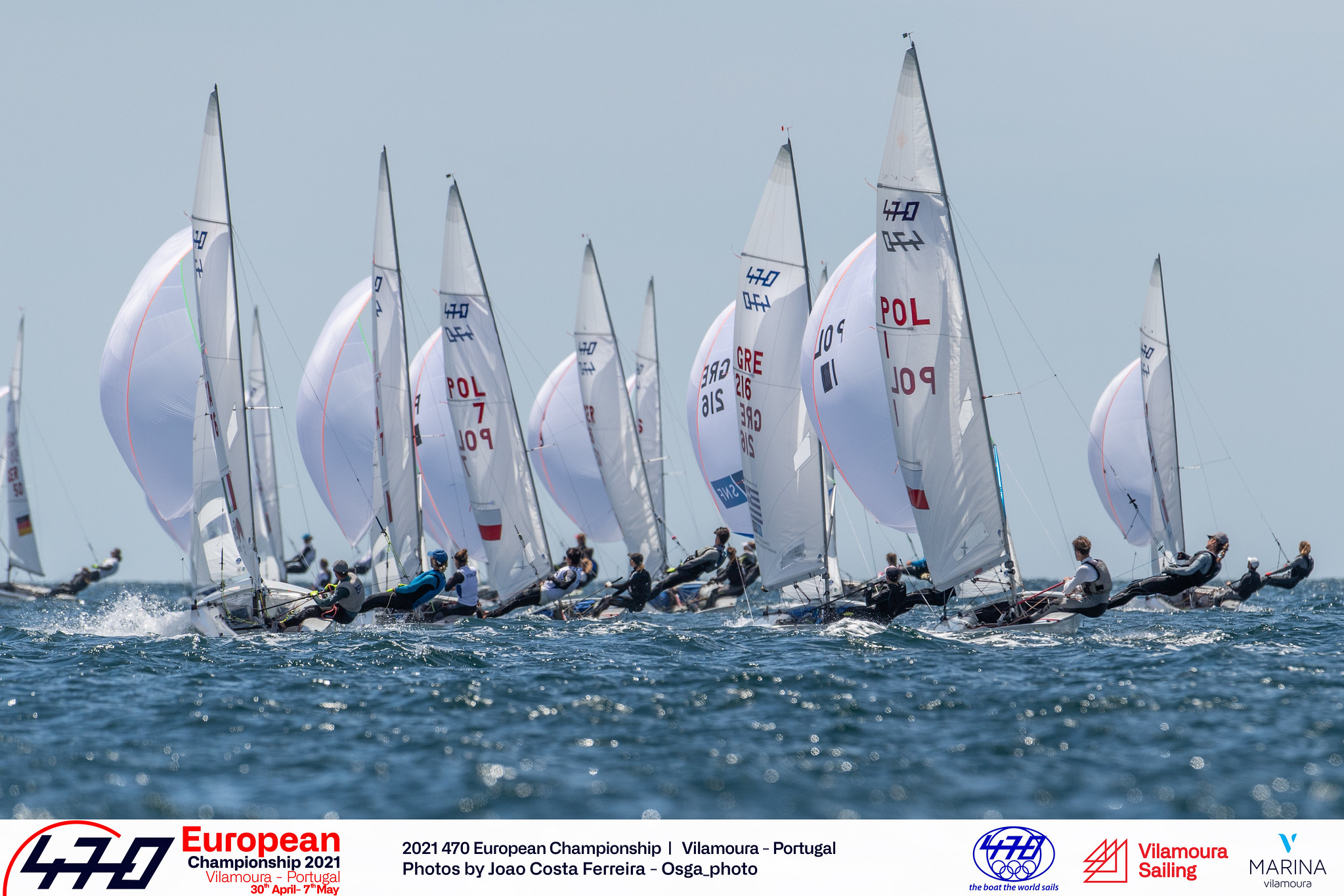
2021 Europeans Vilamoura POR
- All video galleries
- News + Views
- Youth Pathway
- 470 IN 2024
- Why Sail 470?
- ORGANISATION

Hannah Mills/Saskia Clark (GBR) win Rio 2016 Olympic Gold © Sailing Energy/World Sailing

Andreas Kosmatopoulos/Andreas Papadopoulos (GRE) @ Beijing 2008 Olympics © Sailing Energy/World Sailing © David Bell

470 Racing @ London 2012 Olympics © Thom Touw

Geison MENDES/Gustavo CANAL THIESEN (BRA) @ 2019 Tokyo Test Event © Sailing Energy/World Sailing

Anton DAHLBERG/Fredrik BERGSTRÖM @2019 470 Worlds Enoshima JPN © BULKHEAD magazine
The 470 is the equipment used for the Men and Women's Two Person Dinghy event at the Olympic Games. Our World Championships usually attract more than 130 boats.
A 470 skipper usually weighs between 50 and 65kg with a crew around 65 to 75kg. The class was designed in 1963 by Frenchman Andre Cornu. It made its first appearance at Olympic Games at Montreal in 1976 as an open gender event, remaining so until it was split into seperate mens and womens events in Seoul 1988.
The class is renowned for its close racing, and is known as the most 'technical' class in the Olympic Games. But no one sails them because they like fiddling with little ropes, nuts and bolts instead of sailing. The real reason anyone sails a 470 is because of the challenges they present.
All the options available are a lot to get your head around. The 470 has no set position for the mast step, no set lengths for the stays, typically sets up with adjustable spreaders and allows for variations in sail and foil design. A 470 skipper has lines controlling the mainsheet, traveller, vang, cunningham, jib car position, centreboard and rig tension at their side. The foremost challenge of sailing a 470 is understanding the tuning and set up of the boat, then being able to balance making changes in the boat with sailing fast and racing.
Its next challenge lies in setting up with a symmetrical spinnaker and the class rules suspending Rule 42 to allow kinetics when the breeze is greater than eight knots. Sailing with a spinnaker on a moving pole opens up an array of downwind angles, ranging from close reaching to soaking deep by the lee. Imagine coming around the top mark and seeing the boats around you fly off in different directions with no idea which way will prove to be fastest. The best 470 sailors have an arsenal of downwind styles available and are able to switch in and out of them to not only stay fast, but to race smart as well.
Open up every downwind angle and you open up an array of pumping and ooching styles, meaning that 470 sailors are literally forcing their boats downwind faster than they want to go. A significant development over the last Olympic cycle has been the refining of the upwind pumping, with many crews now unhooking from the wire in early trapezing conditions to use their full force to pump the rig in a manner similar to a bird flapping its wings. It is not unusual to see see a fleet of 470s starting in around 10 knots with all of their sails beating like windsurfers.
The 470 isn't a boat you can just buy in a box. It isn't a boat with magic go fast numbers or equipment. The range available means that the sailors have to spend the time to develop and understand their own styles, techniques and equipment to get to the top. It can be funny to observe the different personalities, ranging from the neurotic tuners to the ballpark set and forgetters, interacting in the boat park before a regatta. Like all Olympic classes, the 470 is a class you need to devote a significant amount of time an energy to before you start to master it. But as you get closer, you get a lot of satisfaction feeling every little advance in speed and technique coming together
470 Speed Guide by Sîme Fantela
2016 Gold medalist and North Sails expert Sîme Fantela answers your questions about sailing the 470...
Who sails the 470?
The 470 has been an Olympic double-handed class since 1976, with separate men’s and women’s divisions since 1988. Today most sailors are full-time Olympic hopefuls, and because the boat is so technically and physically challenging many teams stay together for several four-year training cycles. The boat can be sailed by a range of weights and heights, though most helms are shorter and smaller than their crews to maximize righting moment. Men’s helms range from 55-65kg and crews from 65-80kg, aiming for a combined weight between 130-140kg. Women’s teams are usually bit smaller, targeting between 120-130kg of combined weight.

What does it take to be successful in the 470?
You need to be passionate about it. You need to be focused on the training process, you really need to enjoy the boat and sailing and the hard work that comes with it. Competing successfully is not only about sailing and tactic; it’s a lot about the technical side of the class. To be successful, you need to understand how the boat works, how the foils work, how the mast and the sails work, and how all these things work together. It’s very important to feel all these things, so you can tune the boat well in different wind ranges.
Who does what on the boat?
Upwind, the helm is steering and controlling the mainsheet, cunningham, and vang, as well as adjusting the centerboard up and down. The crew is responsible for trimming the jib, and obviously for hiking and the balance. Most of the boat handling and the kinetics are the crew’s job.
Downwind, the helm hoists the spinnaker and trims it temporarily while the crew is setting or dousing the pole. The crew trims the spinnaker and balances the boat both fore and aft and side to side.
What are the keys to rig set-up?
The most important aspect is to understand what suits your team. If you are a standard size (small-light helm and tall-heavy crew), follow the North Sails Tuning Guide . If you are not a standard size, you will have to work at finding the right mast stiffness, spreader length, mast step position, centerboard pivot position, centerboard stiffness, and model of sails. Then you can start to fine tune the boat and rig, depending on feedback from sailing against other teams.
What are the keys to rig tuning?
The key adjustment is rig tension. There are two different setups: the “standard” has less purchase, and the “soft” is easier to play while racing. You can choose which kind of purchase you want when ordering a boat. Many experienced teams choose the soft purchase, so it’s not just how much experience you have; everyone has their own tuning styles and ways. There are some very useful photos of this and other systems on the McKay Boats website .

Upwind Sailing
Where does each person sit on a 470 in light air.
Sit as far forward as possible. If the crew is not on trapeze, then they sit on the deck and try to press the boat flat by leaning out. As the breeze comes up, they move onto the trapeze, first with knees bent and then with knees straight. Once the crew is fully extended, the helm starts to hike.
What are the key changes in different conditions?
It is very important to understand when you go from underpowered to overpowered. Sail trim and crew position are important adjustments until you are fully hiking. Then you start depowering the boat with the different controls.
What do you focus on when trimming the 470 main?
Trimming the main, the focus is the leech and twist. The perfect amount of twist depends on the sea state. If it’s flat water, I like a tight leech, but I don’t ever close it completely. In waves, more twist makes it easier to steer.
What do you focus on when trimming the 470 jib?
You need a different setup depending on whether it’s flat water, chop, or swell: more twist in the waves, and less twist for flat water. I play with the lead in gusts and lulls; you can move it fore and aft, and also in and out (there are 5 positions, and 1 is max inboard while 5 is max out). In light wind, you want it inboard and forward; for strong wind, ease it out and/or move it aft. This helps to open or close the slot between main and jib.
What are the key adjustments to make when wind and sea state increase?
Key adjustments are centerboard height, jib lead, vang, outhaul, cunningham, and the height of the jib. Let’s say the wind is starting to build. To depower the main, pull on cunningham, outhaul, and vang. For the jib, lower the height, pull on jib cunningham, and move the jib lead aft/out. If you are still overpowered, raise the centerboard.
Any other advice about gear changing in a 470?
You need a lot of hours in the boat to understand how it feels in different conditions and what the boat wants to be quick. You need to have all these tools in your hands and to adjust when conditions change, or when you want to change the mode of sailing. If you want to go quick and low, or slow and high, you need to be able to do it—and this doesn’t come easily.
What’s the typical conversation between 470 helm and crew?
It’s mostly about who is doing what on the boat. On our boat, as helm I was doing the tactics and my crew was focused on speed, but sometimes when the conditions changed we would swap roles; I would focus on speed and the crew would take over tactics. The other loop is talking about boat speed: how do we feel, should we change something? You always compare yourself with the boats around you about the speed and mode of sailing.

Downwind Sailing
What 470 spinnaker would you recommend.
North Sails has three different models: V2, A2, and V3. The V2 is flatter on the top and easier to steer to. The A2 has the biggest projected area, it’s the most powerful one. The V3 is a bit fuller on top. So each team should decide which kite to use depending on their style of sailing—if they want to sail low, or want to play with the waves and sail high. For more details, view the North Sails 470 Inventory.
Where does each person sit in a 470 downwind?
Downwind, the helm sits on the leeward side and the crew sits to windward to trim the spinnaker. In lighter breezes the crew sits as far forward as possible, close to the shroud; one trick in super-light winds is to sit in front of the shrouds, just at the splash rail, to lift the stern out of the water and minimize the wake.
As the breeze comes up, the crew moves aft—sometimes even behind the traveler bar. In really extreme big breeze and waves, both the helm and crew will sit all the way aft, close to the rudder, to put the bow up and surf as much as possible.
What are the key adjustments to make sailing downwind?
It’s important to feel the sea state and decide how high to sail compared to the waves; you don’t want to stop in the waves, you want the boat to plane. You have to find your own way of sailing depending on the fleet, the waves, and the wind. The fastest teams spend a lot of time sailing the boat downwind in different wind conditions, because in this class the biggest gains are made downwind.
Downwind, you want the main as deep as possible in almost all conditions. Ease outhaul and cunningham, and adjust the vang so that the leech is open for a nice flow around the main. Having the top batten parallel with the boom is good as a starting point, and then you fine tune from there.
Another good rule is to keep the spinnaker pole parallel with the boom as it goes in and out. If you let out the boom, move the spinnaker pole aft. If you start to sail higher angles and pull in the boom, let the pole forward. These rules work in most conditions.
What’s the most important thing about 470 trimming downwind in light air?
Keep the slots open between kite, jib, and main. If it’s really light, so you can’t pull back the spinnaker pole, you’ll need to trim in the main.
What’s the most important thing about 470 trimming downwind in heavy air?
Let the boom out to the shroud and raise the pole to close the leech of the kite, keeping as much power as you can handle. Then focus on crew work: working the waves, balancing the boat. The higher the centerboard, the faster you will go, so you want to lift it as much as possible—but that depends how much stability you need. As a beginner, start with the centerboard down more, to have a more stable boat. As you get better controlling stability with bodies and sails, the centerboard can go higher and you’ll go faster.
What is a typical conversation downwind?
Here are the two questions:
- What mode do we want to achieve (high and fast, or low and slow)?
- Is the Oscar flag up so we are allowed to pump?
If we are pumping, usually the helm counts down the timing: three, two, one, pump. We try to move our bodies together and pump the main and spinnaker together. The most important thing downwind is to catch waves while being synchronized as a crew.
Any special considerations to sail the 470 well downwind?
You have to listen to what the boat tells you and how it feels, then listen again to how it reacts to a change of mode. One mode might suit your team best, but you still have to master the others to be quick in different tactical situations.
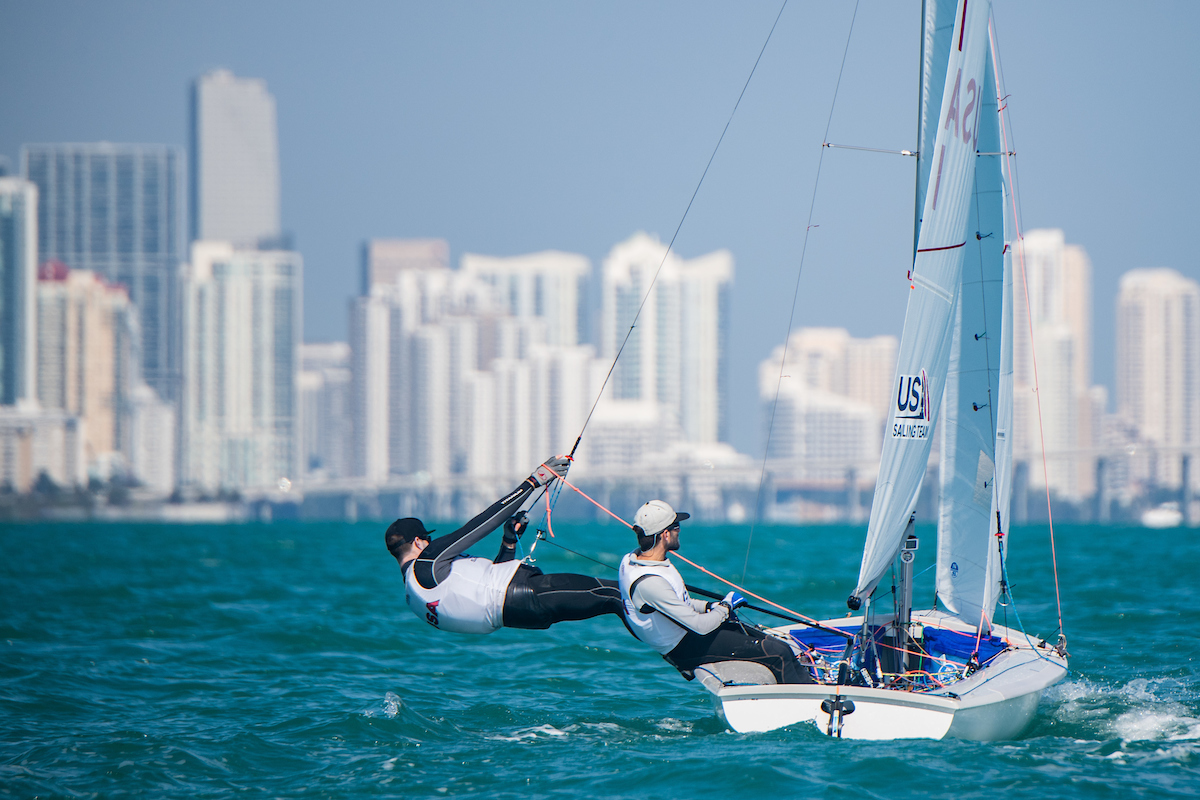
Boat Handling
Top three tips to starting a 470 well.
- Try to keep the flow on the rudder and centerboard as long as you can. Once you lose that, it can take some time to attach again.
- Always fight for space down to leeward. If you don’t have enough, you’re not going to survive the first 100 meters.
- Identify the last possible moment for a double tack. And whether you double-tack or not, know the right time for good acceleration and the right exit angle.
Any tips for 470 downspeed boat handling?
The most important thing is to keep flow on the rudder and centerboard. If you are going slow, keep the main in. If you have to kill speed, luff the jib but try to keep flow in the main as long as possible.
Work bodies and sails together. It is really crucial to be synchronized: at the start, both helm and crew go to leeward, prepare for the acceleration, and then squash the boat flat and trim in main and jib at the same time. Sheeting and flattening the boat together is the only hope for a good start.
What is the most common mistake when tacking a 470?
Not synchronizing helm and crew with rolling the boat into the tack, not flattening at the same time on the exit, and not maximizing the roll.
What does each person do in a tack?
The helm sheets the main in tight as you come head to wind and then eases it out again. Once on the new tack, trim in as the boat accelerates. The crew needs to balance the boat and provide the right amount of heel, while at the same time trying to be precise with jib trim. It’s quite a tough job for the crew to do a really nice tack.
Key tip for good light-air tacks in a 470?
Maximize the roll of the boat by putting the leeward shroud almost into the water before the tack. When you roll to windward, put that side into the water, and then squash the boat flat on the new tack. All this must be combined with simultaneous trimming of jib and main. The most important thing tacking in light winds is to maximize the power that you have in the boat and what you create with the tack.
Key tip for good heavy-air tacks?
Don’t roll the boat; keep it flat both entering and exiting the tack.
Key tip for good light-air jibes?
In light air, try to turn with minimum rudder and work on the kinetics for roll jibes. The biggest mistake is not to roll the boat.
Key tip for good heavy-air jibes?
Keep the spinnaker full through the jibe, and keep the boat flat; if you roll the boat at all, you risk a capsize.
What’s the best way to set a 470 spinnaker? Who does what?
It’s really important to have a solid routine for spinnaker sets. The fastest set we found was for the crew to:
- Come in off the trapeze wire.
- Take the spinnaker tack out of the spinnaker bag with one hand, while pulling on the windward barber-hauler/twing with the other hand.
- Hook the pole to the sheet, topping lift, and mast – Jaws up!
As the crew sets the pole, the helm stands up and hoists, then grabs a sheet in each hand. (In medium and strong breeze, steer with the rudder between your legs.) You can fill the spinnaker before the crew sets the pole.
It’s important to have the leeward sheet marked at the right amount of trim, so when the spinnaker goes up, it fills automatically before the crew or helm takes it from the cleat.
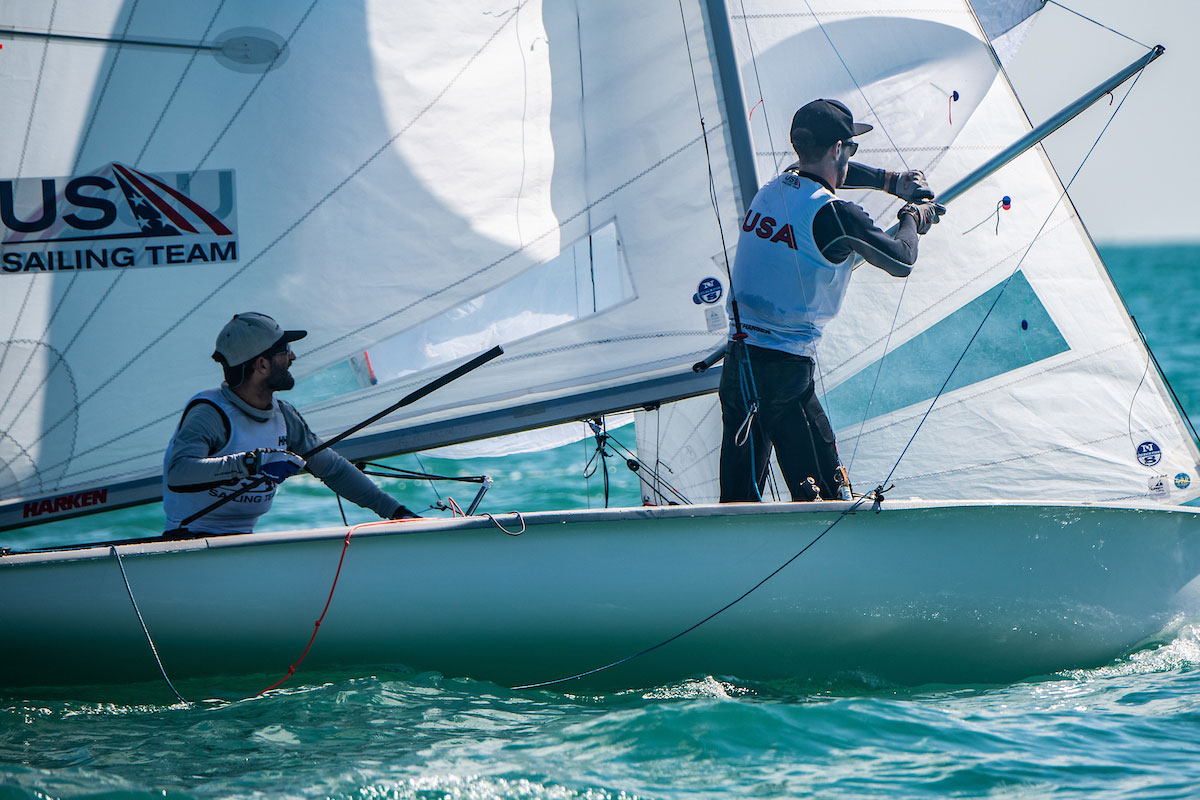
What’s the key to a good 470 spinnaker takedown?
The best spinnaker takedown is when the helm stands up and trims the spinnaker with a sheet in each hand, so when the pole comes down the spinnaker is still flying. At the last possible moment, the crew grabs the tack and drops it into the sock. The goal is to keep the spinnaker flying as long as possible.
Personal Tip: We always have a windward takedown, because we have a storage bag on each side of the boat.
Doing a 720 penalty turn is slow. What are the keys to minimizing the pain?
Try and synchronize the roll of the boat while minimizing the steering. When crew and helm act as one body, that’s the best. If you can, do the spins almost without the rudder, and start with a tack. On the bearaway, have a nice windward heel into the jibe, again minimizing the steering by working the bodies together. Always tack first, even from downwind.
How easily does the 470 broach or capsize?
Not that easily. Downwind, or reaching in strong breeze, you might broach if you lose control of the rudder because it ventilates, which happens quite often. Or in strong breeze if you lose your balance, or roll the boat too much in the jibe, you definitely will capsize.
How do you recover from a 470 capsize?
Try not to let the boat fully capsize, unhook the spinnaker pole, and right the boat.
What are the most common boat helming mistakes made in the 470 class?
When you are not in control of the boat. Control the feel of the boat upwind and downwind, and you’re going to do well.
Any suggestions for drills to improve 470 boat handling?
Sailing a figure eight in any wind will take you far. Circling around one mark, even in 20, 25 knots, is a really good drill to be strong in boat handling. Or set up a short race course that gives you just enough room to put up the kite, do one jibe, take it down, and go back upwind. That will improve your boat handling in all conditions.
Related Articles

Kevin Burnham, Olympic gold and silver medallist in the 470, has died at the age of 63, just week after the passing of another legend of the class, Dave Barnes. This photo says so much about the force of nature that was Kevin Burnham...

Hannah Mills gives an insight into what it took to win the 470 Women's gold medal with Saskia Clark at Rio 2016. " I was completely unprepared for how different an experience Rio would feel to London. London felt like the official Games, where you absolutely knew it was the Olympics and everything was where it should be. Rio however, felt like a very relaxed Games where you really had to focus on the fact it was the Olympics and this was it!!!"

Mike Holt (USA), World 5O5 Champion 2014, 2015, 2017, talks about setting up a 5O5

USA 470 Olympian Dave Hughes explains the multi-tasking challenges of trapezing whilst attempting to execute sail trim, strategy and tactics, at world-class level...

How much difference does upwind pumping add to a 470's boatspeed?

Luke Patience won Olympic silver with Stu Bithell at London 2012. One of the deep thinkers in the sport, Patience is a big believer that you need to understand the ‘why’ of what you do, the reasons behind why the things you do.

Hannah Mills & Eilidh McIntyre are out to defend their 470 class world title as they go into battle against the world’s best just four months out from Tokyo 2020. The 2020 470 World Championships in Palma will be one of the last opportunities for Mills and McIntyre to test themselves against their rivals before the Olympics....

On this month’s show we start a new series building up to this summer’s Olympic Games. We start by looking at the favourites for medals in the 470 and bring you our guide to the sailing venue in Enoshima...

Dave Hughes talks about how he won the 470 European Championships recently with helmsman Stu McNay. This American team is really starting to set the pace. Dave also talks about the loss of his great friend Trevor Moore....
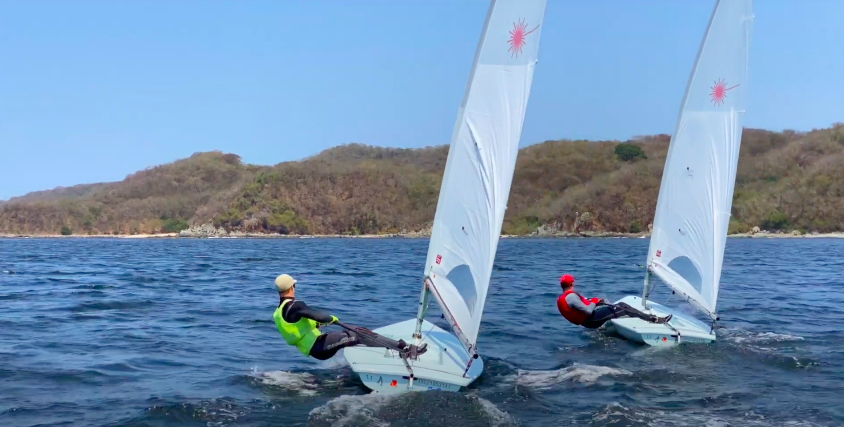
It's an absolutely critical skill any boat. Whether or not you sail a Laser/ ILCA dinghy, this is still a great source of tips for holding your lane...

A great example of how to make your training fun and unpredictable...
| Are you signed up to ? It's our free monthly newsletter full of advice, tips and techniques from the world's best sailors. What's more, we'll send you a free copy of our ebook – guaranteed to bring some fresh ideas to your sailing. Click the button below and take your sailing to the next level!
|
Great choice! Your favorites are temporarily saved for this session. Sign in to save them permanently, access them on any device, and receive relevant alerts.
- Sailboat Guide
Catalina 470
Catalina 470 is a 47 ′ 8 ″ / 14.5 m monohull sailboat designed by Gerry Douglas and built by Catalina Yachts starting in 1998.

Rig and Sails
Auxilary power, accomodations, calculations.
The theoretical maximum speed that a displacement hull can move efficiently through the water is determined by it's waterline length and displacement. It may be unable to reach this speed if the boat is underpowered or heavily loaded, though it may exceed this speed given enough power. Read more.
Classic hull speed formula:
Hull Speed = 1.34 x √LWL
Max Speed/Length ratio = 8.26 ÷ Displacement/Length ratio .311 Hull Speed = Max Speed/Length ratio x √LWL
Sail Area / Displacement Ratio
A measure of the power of the sails relative to the weight of the boat. The higher the number, the higher the performance, but the harder the boat will be to handle. This ratio is a "non-dimensional" value that facilitates comparisons between boats of different types and sizes. Read more.
SA/D = SA ÷ (D ÷ 64) 2/3
- SA : Sail area in square feet, derived by adding the mainsail area to 100% of the foretriangle area (the lateral area above the deck between the mast and the forestay).
- D : Displacement in pounds.
Ballast / Displacement Ratio
A measure of the stability of a boat's hull that suggests how well a monohull will stand up to its sails. The ballast displacement ratio indicates how much of the weight of a boat is placed for maximum stability against capsizing and is an indicator of stiffness and resistance to capsize.
Ballast / Displacement * 100
Displacement / Length Ratio
A measure of the weight of the boat relative to it's length at the waterline. The higher a boat’s D/L ratio, the more easily it will carry a load and the more comfortable its motion will be. The lower a boat's ratio is, the less power it takes to drive the boat to its nominal hull speed or beyond. Read more.
D/L = (D ÷ 2240) ÷ (0.01 x LWL)³
- D: Displacement of the boat in pounds.
- LWL: Waterline length in feet
Comfort Ratio
This ratio assess how quickly and abruptly a boat’s hull reacts to waves in a significant seaway, these being the elements of a boat’s motion most likely to cause seasickness. Read more.
Comfort ratio = D ÷ (.65 x (.7 LWL + .3 LOA) x Beam 1.33 )
- D: Displacement of the boat in pounds
- LOA: Length overall in feet
- Beam: Width of boat at the widest point in feet
Capsize Screening Formula
This formula attempts to indicate whether a given boat might be too wide and light to readily right itself after being overturned in extreme conditions. Read more.
CSV = Beam ÷ ³√(D / 64)
Wing keel versions draft: 5.5’/1.68m
Tall rig with mast moved aft:
I: 62.67’ / 19.10m J: 17.83’ / 5.43m P: 56.92’ / 17.35m E: 20.00’ / 6.10m
Embed this page on your own website by copying and pasting this code.
- About Sailboat Guide
©2024 Sea Time Tech, LLC
This site is protected by reCAPTCHA and the Google Privacy Policy and Terms of Service apply.
- BOAT OF THE YEAR
- Newsletters
- Sailboat Reviews
- Boating Safety
- Sails and Rigging
- Maintenance
- Sailing Totem
- Sailor & Galley
- Living Aboard
- Destinations
- Gear & Electronics
- Charter Resources
- Ultimate Boating Giveaway

Sailboat Review: Dufour 41
- By Herb McCormick
- September 17, 2024
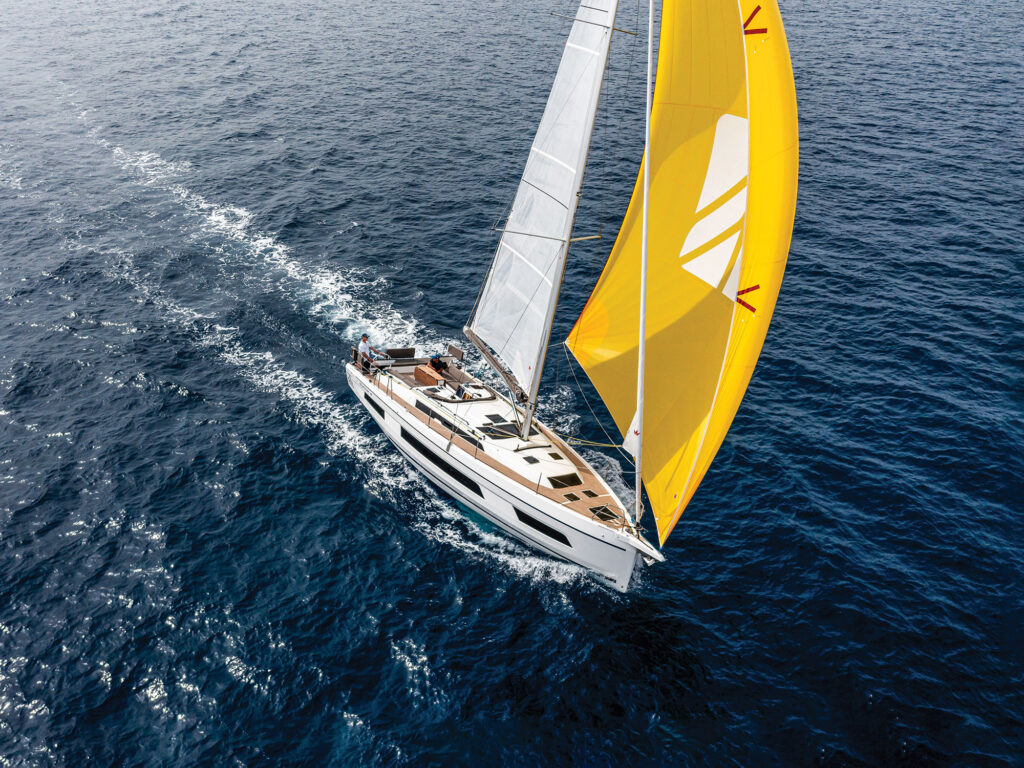
When it comes to a discussion of the great European naval architects of contemporary times—and it’s a long list, indeed—certain names immediately pop to mind. Many are French. Philippe Briand made his mark creating boats for a roster of production builders (Baltic, Jeanneau, CNB) before pivoting to the superyacht set (Perini Navi, Royal Huisman). Jean-Marie Finot was more or less the father of an era of the best Vendée Globe solo round-the-world racers ever to compete in that grueling contest. Marc Van Peteghem and Vincent Lauriot Prévost (VPLP Design) are the current masters of offshore multihulls. The talented tandem of Jean Berret and Olivier Racoupeau are ubiquitous as the creators of many French brands, and sit at the forefront of their profession.
To me, however, one of the more underrated European design mavens, and one who definitely belongs in that rarefied grouping, is Umberto Felci. While Felci was born in Milan and still operates from his base in Italy, I’ve always considered him a huge influence in French boatbuilding—largely because of his longtime association with Dufour Yachts, where he’s been the principal designer for some 15 years.
During that time, I’ve sailed many a Felci boat, as he’s been a consistent presence in Cruising World ’s annual Boat of the Year contest . He has won multiple times with his Dufour entries, including the 560 Grand Large (2014), the 382 Grand Large (2015), and the 520 Grand Large (2018). All of these Grand Large boats shared a similar DNA, and the Dufour booths at the major boat shows were easily recognizable for their similar lines and matching beige canvas dodgers and sail covers. The only huge difference across the fleet was their respective sizes.
All that changed in a big way in 2019, after the Fountaine Pajot group acquired Dufour and decided to make each new offering a singular model in form and styling. Which brings us to Felci’s newest design, the Dufour 41.
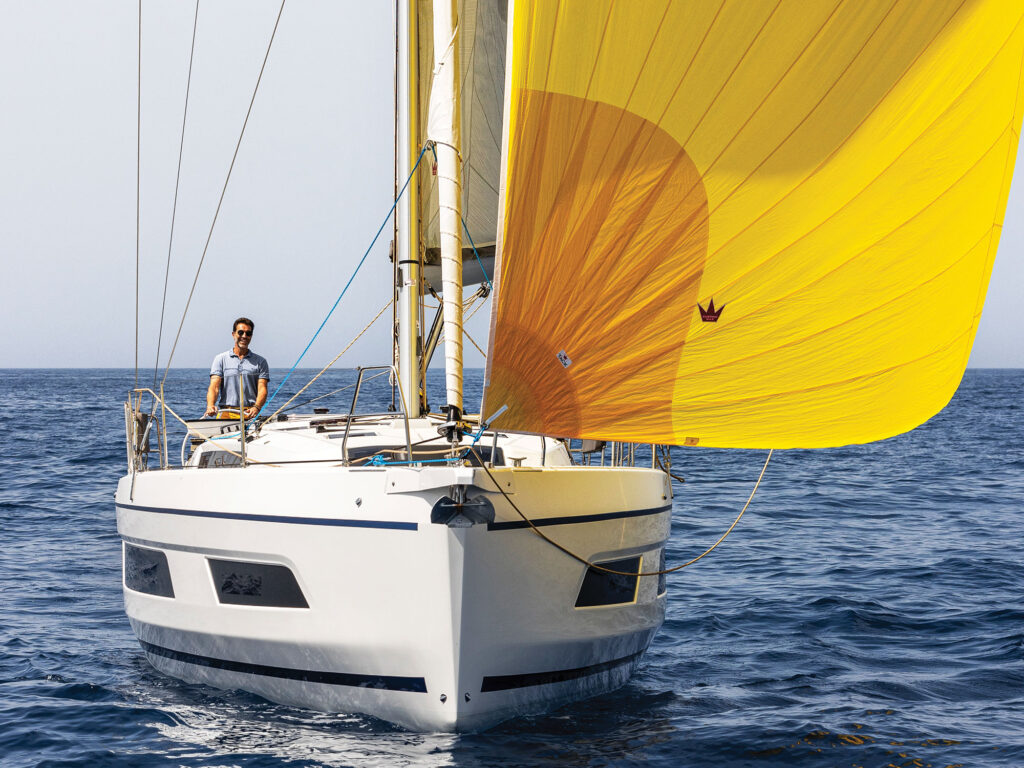
Aesthetically, it’s safe to say that the bright-blue Dufour 41 at this past year’s Annapolis Sailboat Show in Maryland was one of the more distinctive-looking yachts on display. It has a rounded bow, ample beam, and not one but two chines, both carried almost the entire length of the boat—one just above the waterline, another just below the reverse sheer line, which is accentuated by prominent molded bulwarks. This boat looks and feels much larger than its 41 feet length overall. Forward, an integrated bowsprit for the ground tackle and the tack point for the asymmetric kite heightens the futuristic vibe. As does the series of three sleek windows in the hull (along with the additional pair of windows overhead in the coachroof). There is not a stick of timber to be found anywhere.
Topsides, the combination of wide side decks and outboard shrouds makes for easy egress when moving forward or aft. The emphasis on “outdoor living” is underscored by a generous cockpit with twin wheels (but, as with all Dufours, a single rudder, which makes backing down easier and with more control). There’s also wraparound seating, including a cushioned daybed, as well as a drop-down transom, which doubles as the porch/platform for the barbecue well aft. All this is revolved around a table—a pretty sweet, comfortable layout that lends the impression of lounging aboard a much bigger boat.
All the related equipment is first-rate. There’s B&G instrumentation, including the chart plotter and autopilot; a Quick vertical windlass with helm controls for the Delta anchor; and a Side-Power (Sleipner) bow thruster, which I reckon is a luxurious touch on a 41-footer. Our test boat was set up with a nice set of Elvstrøm sails, including a traditional mainsail (an in-mast furling mainsail is available) with a cool stack-pack arrangement that tucks into itself and is secured with shock cords. For our Boat of the Year trials, we test all the emergency rudders, and the one on the 41 was exceptional.
Construction is straightforward and robust. The hull is vacuum-infused with solid glass below the waterline and a foam core above. There are a pair of molded-in channels for the plumbing and electrical wiring. The plywood bulkheads are laminated to the hull. The keel is cast iron. And, as with every Dufour going back to the company’s origins, a wine rack is stashed under the floorboards.
Ardizio Design is responsible for the belowdecks accoutrements, accommodations and floor plan. Its team used those aforementioned chines and, more specifically, the voluminous interior that the chines created, to wide advantage. As with Dufour’s other models, there are three packages of features, trim and equipment—on the 41, these are labeled Adventure, Ocean and Performance—depending on how the boat will be used (basic sailing, dedicated cruising or racing). With the 41, there are also two interior options: either three or four staterooms. Both have a straight-line galley to starboard, with the dining table and wraparound settee to port.
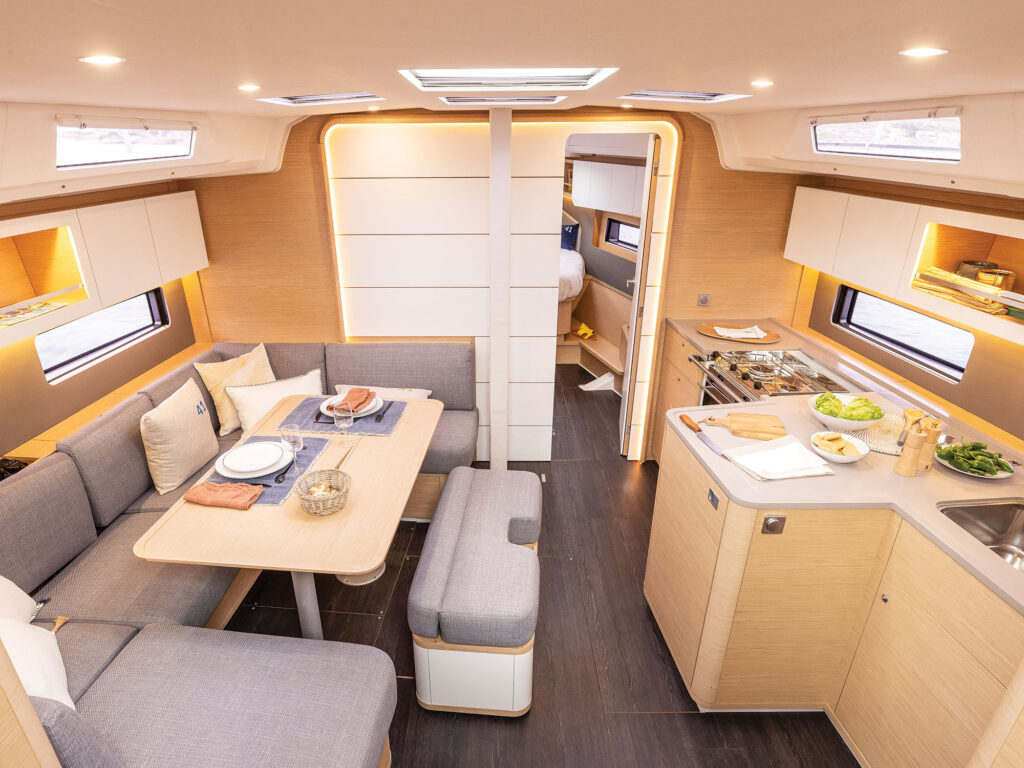
Our test boat had the three-stateroom layout, with a spacious master forward and a pair of double-berth staterooms aft. It also had three heads, which, to be honest, seems like a bit of overkill on a 41-foot boat. The second head, in the center of the boat, can be replaced with stowage, which is the setup I’d prefer.
The 41 sports a double-spreader rig with swept-back spreaders and a self-tacking jib. The double-ended German-style mainsheet, anchored at midboom, is easily trimmed with a pair of electric winches (an optional electric winch for the mainsail is available). There’s no traveler; after all, this is a cruising boat.
Under power, the 50 hp Volvo Penta with a saildrive configuration had us zipping along at better than 6 knots. This was one of the quieter boats, decibel-wise, in the 2024 fleet. But we were all itching to hoist the sails, and we were not disappointed. At first, in a fitful breeze that was just filling in, we still made over 5 knots in 6 to 8 knots of wind. Soon enough, the pressure built into the 10- to 12-knot range, just in time to hoist the boat’s big asymmetric kite. On a tight reach, we made an effortless 7.5 knots, and the helm was just delightful, with only a light three-finger touch required for full control.
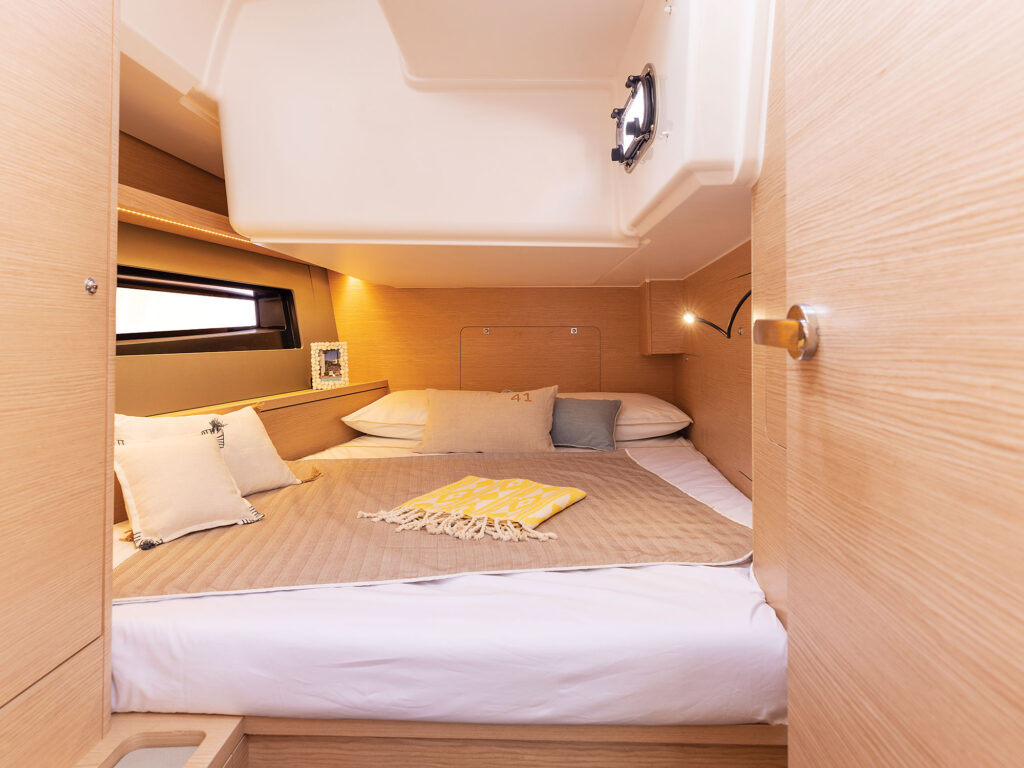
Those Grand Large prizewinners from years past were, of course, all Felci designs. While this new Dufour looks absolutely nothing like its older siblings, it sails just as well, if not better. Felci may have changed the recipe under the company’s new regime, but he hasn’t forgotten that what we really want is pretty simple: We want to go for a fine sail.
Dufour 41 Specifications
| LOA | 41’1″ |
| Beam | 14′ |
| Draft | 6’1″ |
| Sail Area | 792 sq. ft. |
| Displacement | 21,647 lb. |
| D/L | 155 |
| SA/D | 18.1 |
| Water | 66 gal. |
| Fuel | 66 gal. |
| Engine | Volvo Penta 50 hp with saildrive |
| Design | Felci Yacht Design |
Did You Know?
French boatbuilders were pioneers in fiberglass-sailboat manufacturing. Naval architect/engineer Michel Dufour joined their ranks in 1964 with the launching of the Sylphe, a radical (for its time) 21-foot pocket cruiser with a masthead rig and fin keel with attached ballast bulb. More than 400 were built in a 10-year production run.
Dufour has ramped up its introduction of new models in the past five years, and now has nine in production ranging from 37 to 61 feet, with a 44-footer on tap to be introduced in the United States this fall. Of that collection, the company’s 41, 470 and 530 are all available with electric auxiliary-propulsion options.
Dufour has laid out an aggressive growth strategy, planning to introduce two models each year for the next several years, and replacing its entire fleet within four years. As for the 41, a company representative said that about a third of the run will go to private owners, a third will be purchased by charter operators, and a third will go into charter-management programs.
Herb McCormick is a CW editor-at-large and was a 2024 Boat of the Year judge.
- More: Boat of the Year , dufour yachts , Print September 2024 , Sailboat Reviews , Sailboats
- More Sailboats

Pre-Owned: 1988 Hylas 47

Catalina Introduces the 6 Series

Sailboat Preview: Elan GT6 Explorer

For Sale: 1984 Camper & Nicholsons 58

Best Practices for Boat-Show Shopping

Savoring Superior: A Great Lakes Cruise To Remember
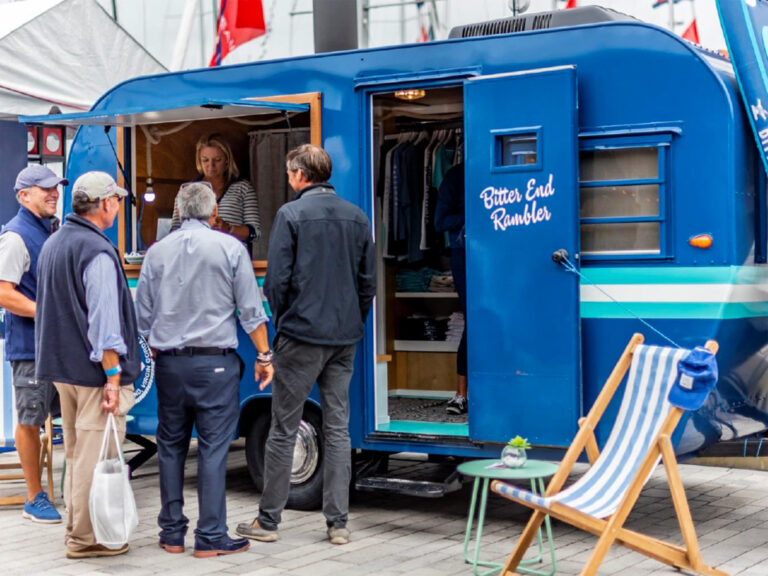
Point Your Compass Due South, Bitter End Yacht Club Reopens October 23rd.
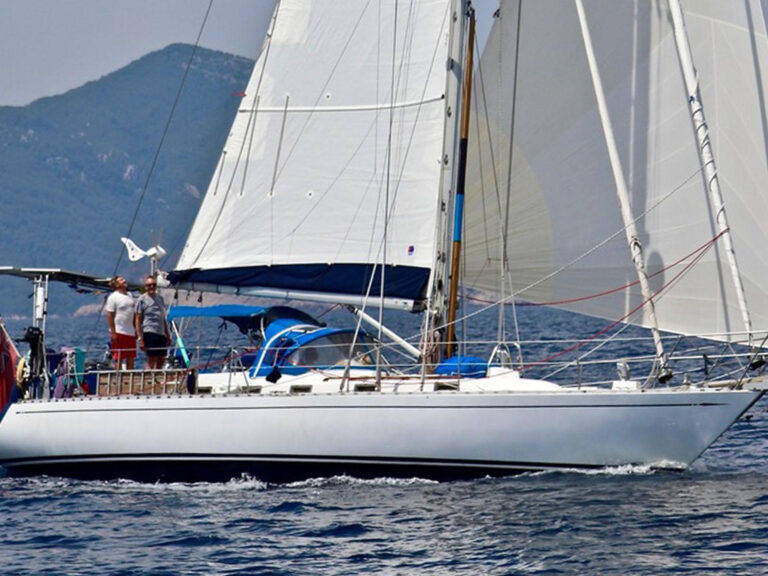
- Digital Edition
- Customer Service
- Privacy Policy
- Terms of Use
- Email Newsletters
- Cruising World
- Sailing World
- Salt Water Sportsman
- Sport Fishing
- Wakeboarding

IMAGES
VIDEO
COMMENTS
The 470 is a fibreglass planing dinghy with a centreboard, Bermuda rig, and spinnaker, designed by André Cornu in 1963. It is a World Sailing International Class and has been an Olympic class since 1976, with separate events for men and women and a mixed event from 2024.
Learn about the 470, a two-person centerboard class with trapeze, sailed in more than 60 countries. Find its dimensions, calculations, designers, builders, associations, and forum topics.
The International 470 Class is the class of boat used for both the men's two person and women's two person dinghy events at the Olympic Games. Used as Olympic equipment since 1976, where the class was sailed as an open event before the introduction of separate events for men and women in 1988, the 470 is sailed in more than 61 nations ...
The 470 is a fibreglass planing dinghy sailed by two people, with a sail area of 12.7m2 and a weight of 120kg. It is an Olympic class since 1976, sailed by men and women in more than 60 nations and 20 different medal-winning countries.
Learn about the 470 sailing boat, a two-person dinghy class used for racing and recreational sailing. Find out its size, rigging, performance, Olympic history, and global popularity.
The 470 is easy to sail, but racing and flying the spinnaker from the trapeze provides additional challenges for sailors. The 470 made its Olympic debut in 1976, and in 1988 was selected for the Games first women's sailing event. ... Boat Specifications. Length: 4.7 m, 15 ft 5 in Weight: 120 kg, 264 lbs Sail Area: 12.7 sq m, 137 sq ft Jib: 3.58 ...
470 is a 15′ 5″ / 4.7 m monohull sailboat designed by Andre Cornu and built by Fountaine Pajot, MacKay Boats Ltd., Parker Yachts, Nautivela, and Mader Bootswerft starting in 1963. ... Dimensions. Length Overall 15 ′ 5 ... The lower a boat's ratio is, the less power it takes to drive the boat to its nominal hull speed or beyond. Read more ...
The 470, named after the overall length of the boat at 4.70m, is a double-handed monohull planing dinghy; equipped with a spinnaker and trapeze, teamwork is key to success in this boat. The optimum weight for the crew is between 120-135kg.
Data And technical specifications of Dufour 470 equipments, fuel economy, dimensions, weight, engine power and prices . Sea Ray; Beneteau; Jeanneau; Bayliner; Bavaria; Azimut; Tracker; Contact us . Home; ... Find All mechanical and electrical parts and accessories of Dufour 470 Sail here ; Dufour 470 competitors. Catalina 315.
Learn from a 2016 Olympic gold medalist and North Sails expert how to sail the 470 double-handed dinghy. Find out about rig tuning, sail trim, crew position, and spinnaker choice in different conditions.
The 470 is a double handed, mixed crew Olympic yacht. The 470 is a light and narrow boat (length 4.7m and beam 1.7m with a weight of 120kg), that responds easily and immediately to body movement. The skipper is normally smaller and lighter (1.65m to 1.8m and 55kg to 65kg) and the crew is taller (1.75m to 1.85m yet only 65kg -75kg).
2008 Olympics - Tornado gold medal, 470 men's bronze medal. Europe Dinghy - 2003-04/2010 women's world champion. Maxim started working in the Quantum Russia office in 2010 after a lifetime of sailing experiences. He started sailing on Optimist boats when he was six years old and became a champion sailor. He is a two-time All-Japan Mini ...
Technical specifications - Dufour 470. Construction site : Dufour. Architect : Felci Yacht. Boat type : Sailboat. The Dufour 470 is renowned for its exceptional qualities that make it a standout sailing yacht. It excels in terms of performance, offering impressive speed, agility, and responsiveness with its well-designed hull and sail plan.
Learn about the permitted status of the 470 boat according to the Class Rules prepared by World Sailing and the 470 Internationale. Find the latest changes, interpretations, and links to download the Class Rules and related documents.
A comprehensive review of the Catalina 470, a performance cruiser with spacious accommodations and moderate beam. Learn about its design, deck layout, systems, fit and finish, and suitability for coastal cruising and short offshore passages.
French sailboat manufacturer Dufour Yachts says it has re-invented itself with its new series of yachts, including the 470, which made its debut in late 2020. In a statement, the company, which is based in La ... Other Specifications The Dufour 470 displaces 29,101.02 lbs. (13,200 kg) and draws 7'5" (2.25 m) with a sail area of 1,151.74 ...
Catalina 470 - Sailboat Data, Parts & Rigging. Sailboat data, rig dimensions and recommended sail areas for Catalina 470 sailboat. Tech info about rigging, halyards, sheets, mainsail covers and more. Sailboat Data directory for over 8,000 sailboat designs and manufacturers.
Learn about the history, challenges and rewards of sailing the 470, the Olympic two person dinghy. The 470 is a technical and versatile boat that requires tuning, strategy and skill to master.
Find detailed information about the CATALINA 470 sailboat, including hull type, rigging type, dimensions, displacement, ballast, sail area, and more. Compare different versions, see sailboat forum topics, and download boat record.
DUFOUR 470 is a fin keel sloop sailboat designed by Felci Yacht Design and built by Dufour Yachts. It has a LOA of 48.72 ft, a displacement of 29,101 lb, and a reported sail area of 1,151.74 ft².
Any tips for 470 downspeed boat handling? The most important thing is to keep flow on the rudder and centerboard. If you are going slow, keep the main in. If you have to kill speed, luff the jib but try to keep flow in the main as long as possible. Work bodies and sails together.
Catalina 470 is a 14.5 m monohull sailboat designed by Gerry Douglas and built by Catalina Yachts starting in 1998. The web page does not provide any owners manual or technical information for this model, only basic specifications and photos.
The Dufour 41, a luxurious Felci-designed cruising yacht, offers a unique and exceptional sailing experience with its bold aesthetics. ... We want to go for a fine sail. Dufour 41 Specifications. LOA: ... feet, with a 44-footer on tap to be introduced in the United States this fall. Of that collection, the company's 41, 470 and 530 are all ...
It takes into consideration "reported" sail area, displacement and length at waterline. The higher the number the faster speed prediction for the boat. A cat with a number 0.6 is likely to sail 6kts in 10kts wind, a cat with a number of 0.7 is likely to sail at 7kts in 10kts wind. KSP = (Lwl*SA÷D)^0.5*0.5